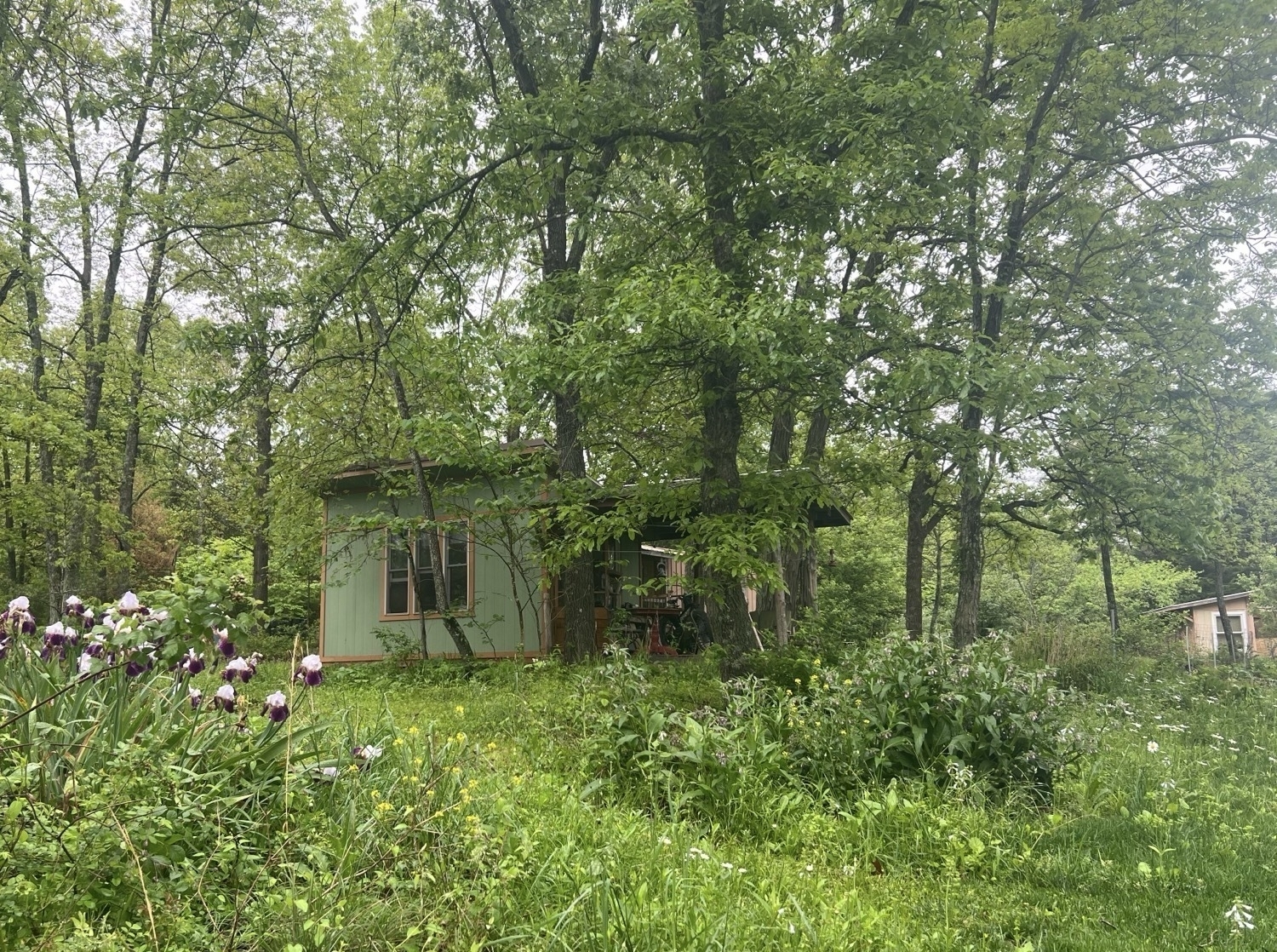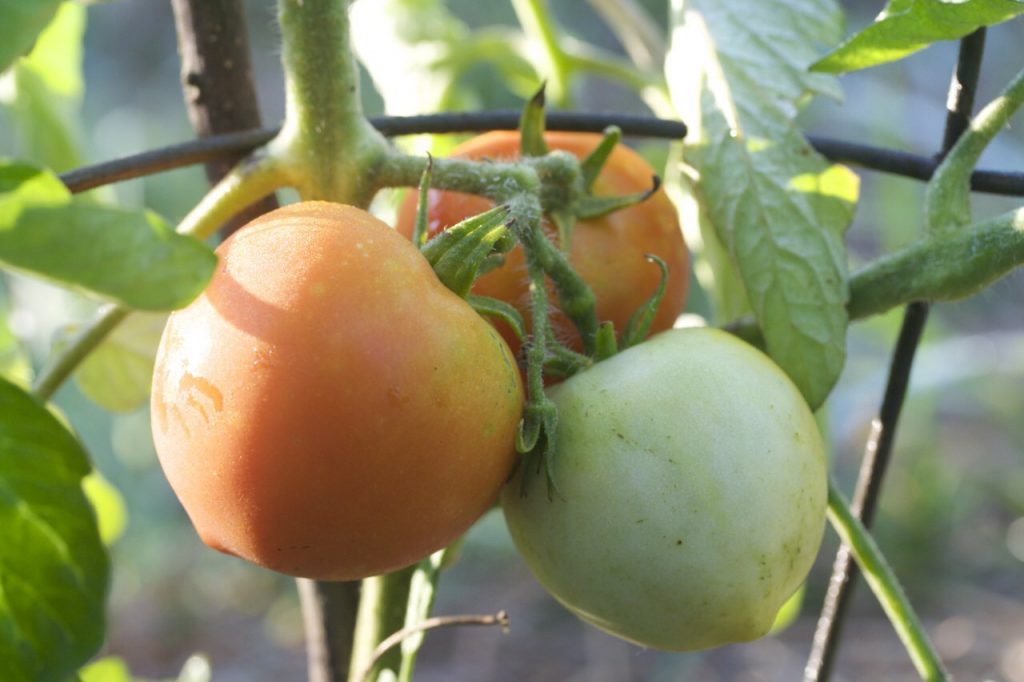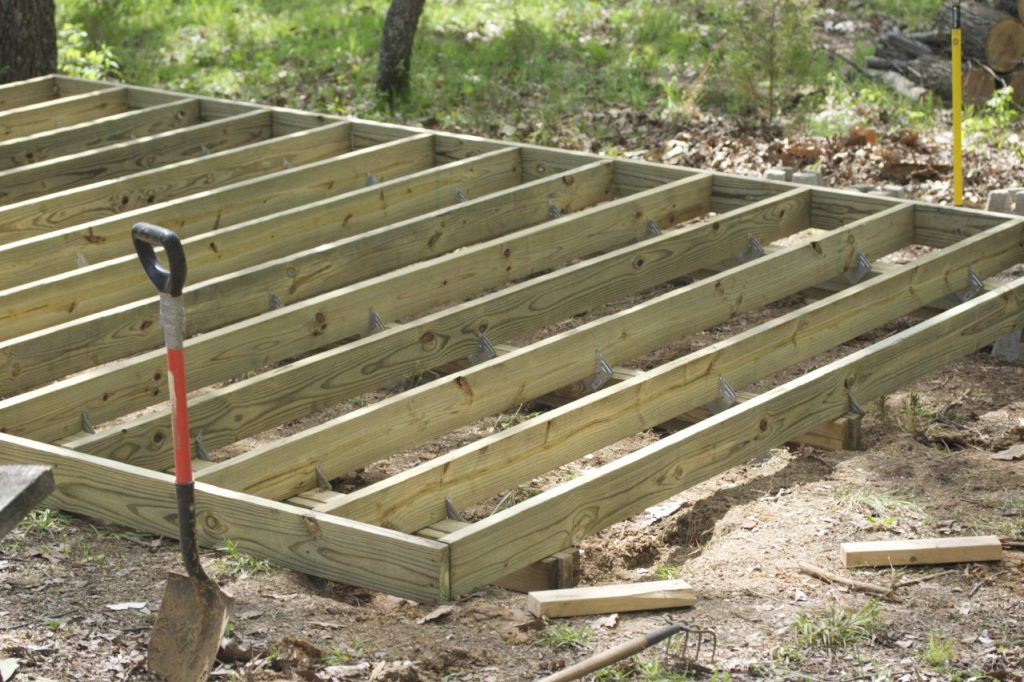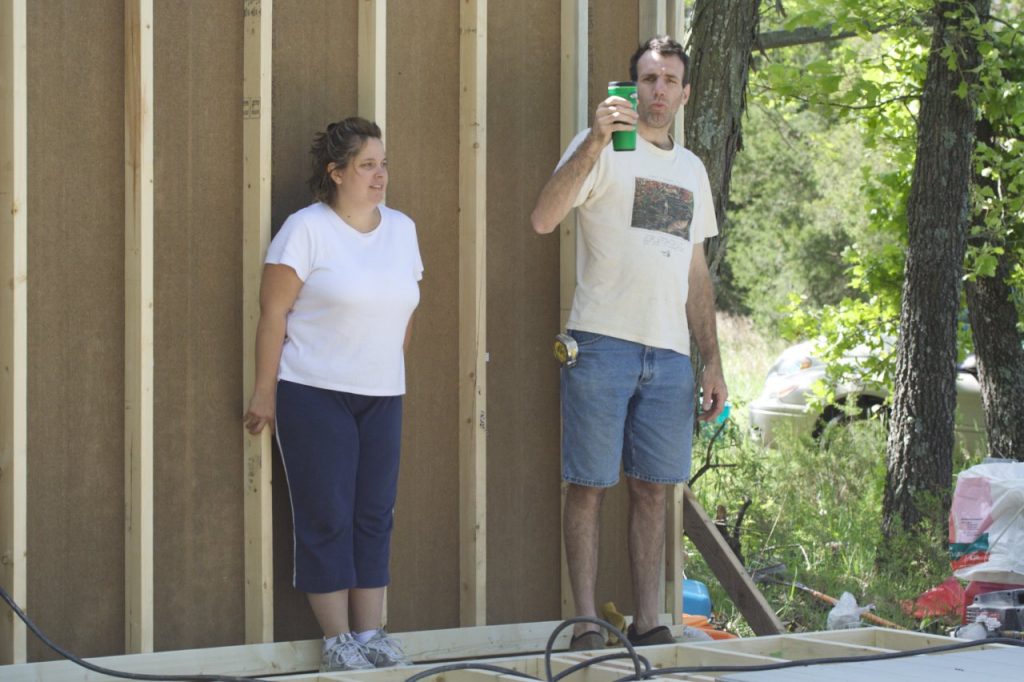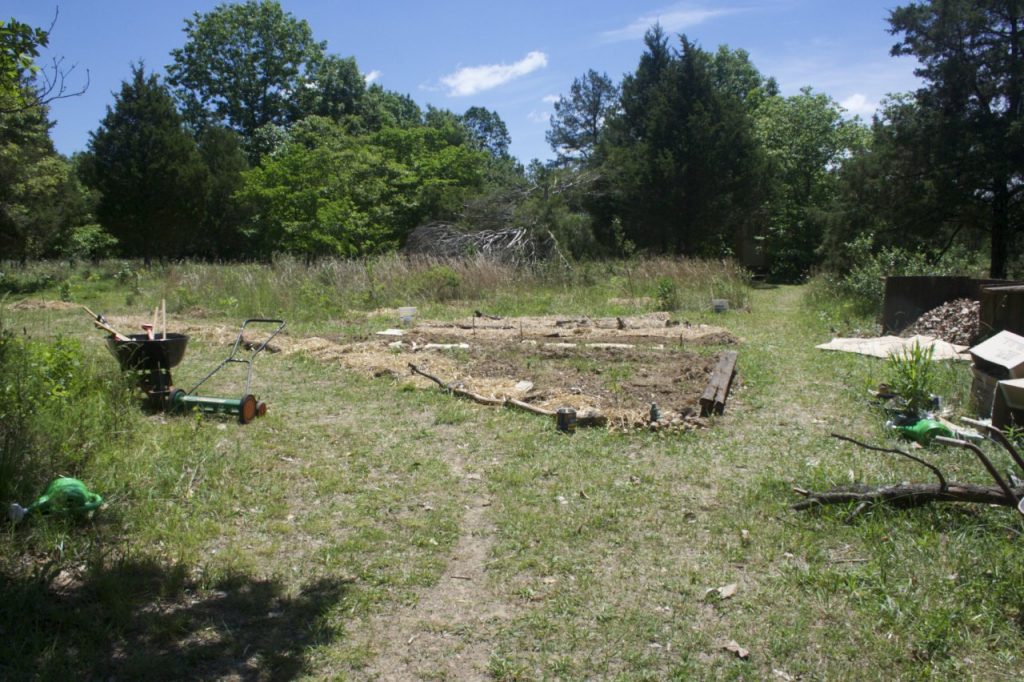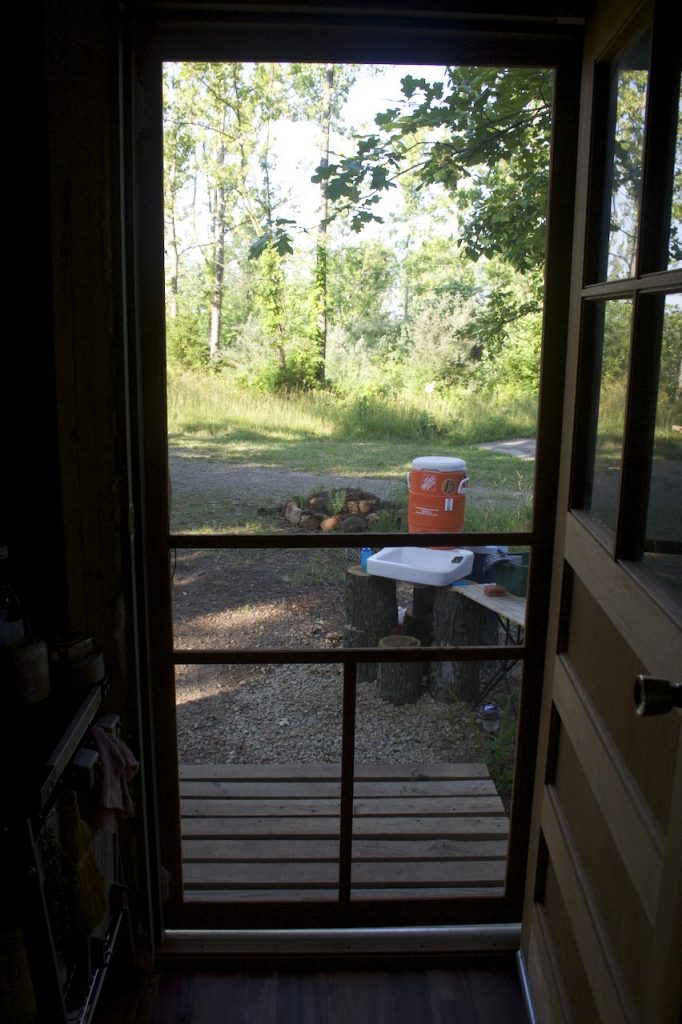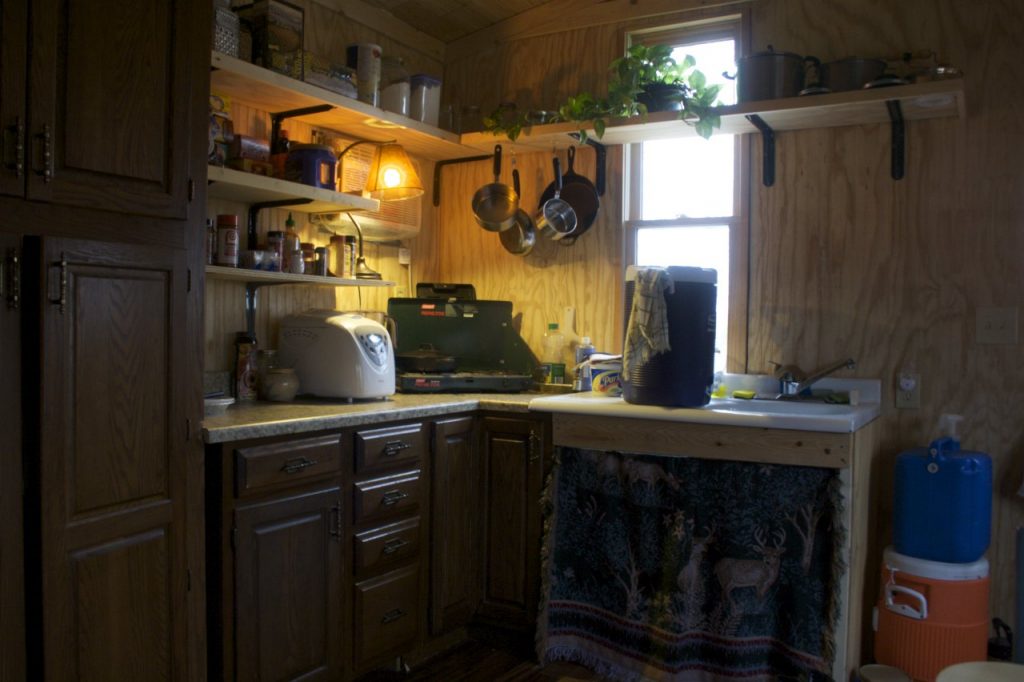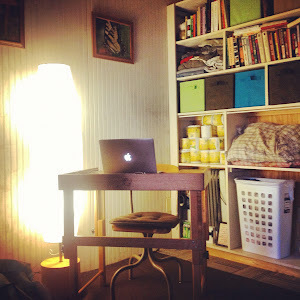Tiny House
- I do own a car but miles driven over the past year are very low at 150. 300 miles over past two years. Only driving necessary trips for groceries/supplies from town. Around 10 trips per year.
- Continue to conserve electricity as much as possible. Example data, it's 55° in cabin this morning. Winter is easier as it's no problem to just add layers as needed. Even at 55-60° I'm cozy and comfortable. Summer is more difficult. Lots of humidity in Missouri but summer temps have been lower than what most have had to contend with the past few years. In any case, as with heating, cooling a smaller space is less energy. I try to keep it between 76-80. Probably averaging 77-78 most days.
- I've not traveled by air in 20 years.
- I have no kids and at 54, single and having had a vasectomy several years ago it's assured I'l continue to not have any.
- My diet is nearly vegan. I do ice cream, occasional cheese, occasional eggs, occasional fish. A note about meat: I don't buy it but if my family are offering fish caught locally I'll eat some of that. Also, if left-over meat of almost any kind is going to get thrown away I'll eat it so it's not wasted.
- I do most outdoor work by hand. As mentioned above, most road work this past fall was with no fossil fuels. My uncle has a tractor and I did help him with his section of road. I worked by hand and helped direct him on the tractor. Surprisingly some things are actually better done with hand tools. I try to minimize grass lawn but I do have some to cut. Also, areas where invasive lespedeza has moved in has to be mowed. I use a battery/electric mower that's charged with solar panels.
- Re-use and recycling. I continue my trend of few to no clothing purchases. Between clothing given to me by folks that are cleaning storage/closets I usually have far more than I need. I've nearly eliminated hard plastic packaging from store bought items. With just one or two exceptions everything I buy comes recyclable steel or in paper or paperboard that I compost. Some food comes in pastic bags (lentils, beans, tortillas) but that's about it. I've recently discovered the joys of waffles made from flour and a waffle iron. I'm not a big bread eater but I'm going to try to use waffes as a bread substitute.
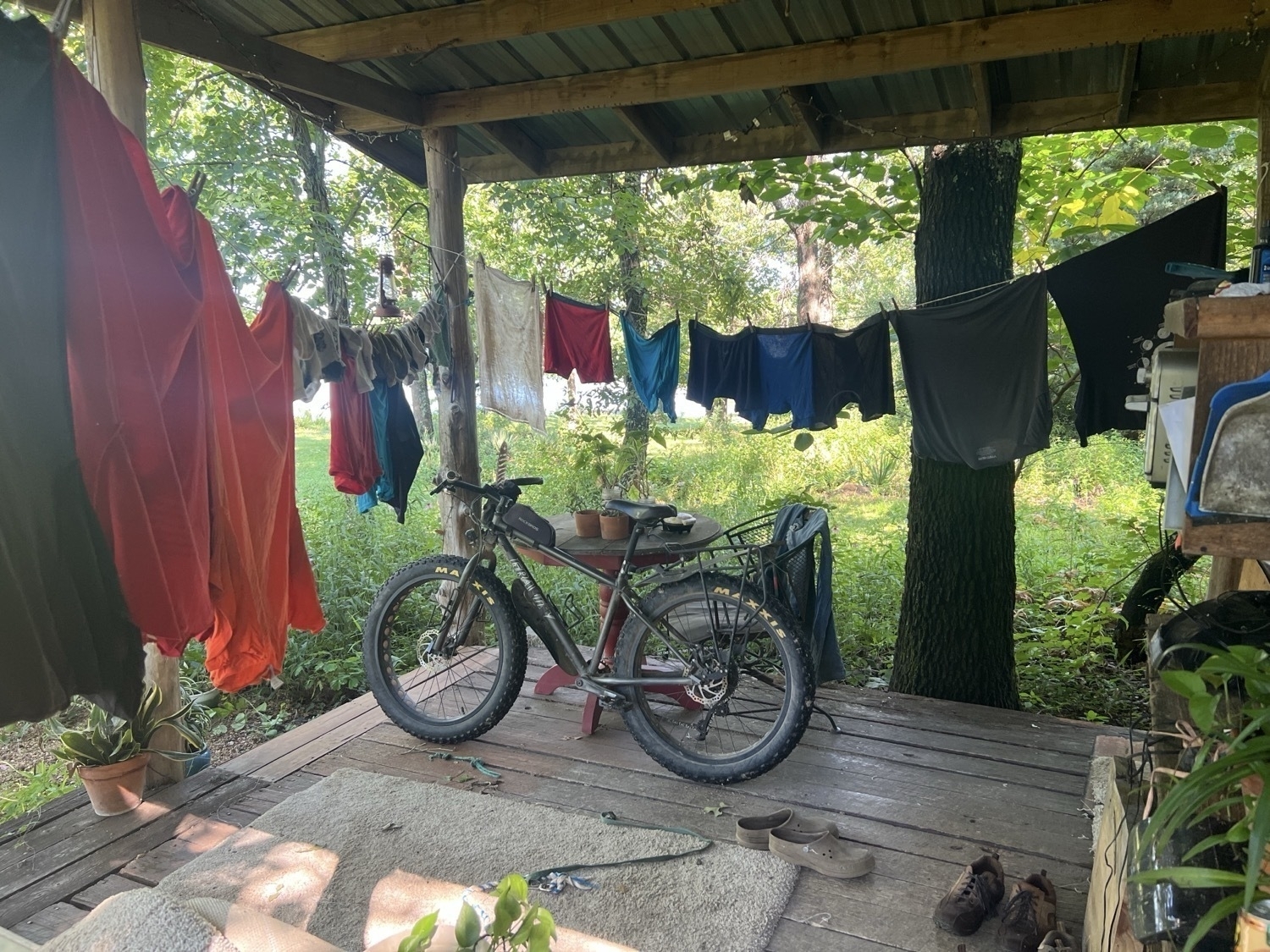
Tiny Life Journal - Laundry day! I don't wash clothes nearly as often as most do. And I keep clothes until they are thin and falling apart. Many of my shirts have holes in them. Also, hang dry is a free, low-tech way to use the sun.
Life in the woods:
I’m sitting on my futon writing when I hear a sound in the cabin. Rosie (my feline friend) jumps up. It’s a bird that has flown through the open screen door. It circles and lands. Takes flight again and finds its way out the door. Yay! Crisis averted. I sit back down and put my hands on the keyboard to continue and yes, in that one moment of flight in the cabin, my feathered friend dropped a poo. And yes, that poo landed on my keyboard. And yes I put my fingers in it. 🤣😬😆
2023 Year in Review (Also, a few interior photos of my tiny house, pardon the mess😂)
My life is generally best characterized as small, slow and steady, I suspect a sharp contrast to most. If you're someone primarily interested in a tech oriented accounting you should skip to the last section. What comes before that is fairly comprehensive and even a bit philosophical in nature. I'm mostly writing this for myself so it's chock-full of details most people likely won't be interested in.
Home and Landscape
I live in a 200 sq ft tiny house that doesn't need much in the way of maintenance or improvements. I often make small adjustments to the arrangement of the space.
The more significant work is spent outside managing various aspects of the landscape. My garden has been small to nonexistent the past couple of years but I still end up spending a lot of time with various projects. This year it was transplanting blackberries and then, later, keeping them alive during a bit of early summer drought. Then daily harvesting in July.
In late August after a third extreme rainfall event and increasing run-off damage to our gravel roads I decided to take care of some long over-due maintenance. As I don't have a tractor this was my daily exercise, 1-2 hours a day. When I started I was unsure of the scope of the work. My intent was to start with the most problematic 40 feet of road and if it went well to continue on to another section. That first section went very well and I had it completed in 4 days. I ended up working on the remaining damaged sections through early December. I'd estimate 90 days averaging About 1.5 hours a day. It went very well. Various sections of road and driveway are much improved and the exercise generally felt very good. There's more to do but I'm taking a break now that it's gotten colder and the road is somewhat frozen.
Another fall project was clearing out several years worth of growth around our well house. I live in the woods and love it. I'm not in the habit of aggressively cutting back trees, shrubs, vines unless there's a reason to do so. This fall some new forest critters decided to make their homes in our shed and well house. Wood rats! These are about the size of squirrels but without the fuzzy tails.
I started noticing nests and food caches of acorns and wild grapes appearing in both my shed and the well house. I removed them and started taking steps to remove any sense of comfort my little friends had in these spaces. I decluttered the shed and made a point of just being out there a bit for a week. It's an old shed, somewhat open to the environment. Not sealed off tightly. My strategy worked.
The well house was another situation. Autumn olive bushes, wild grapes and honeysuckle had crept in all around the well house. The thick growth right up to the building was perfect for my friends. Food, cover, and nesting material. I don't spend much time in the well house but check it in the fall to prepare for winter. That's when I discovered my friends had started moving in.
It prompted me to take a closer look at the building and the surroundings. Where previously I'd seen the approaching mini-forest as a welcome wind break and habitat for birds (hummingbirds like to nest in the thick growth) I now had to reckon with the fact that it was also habitat for these new neighbors that were very determined to get inside the building and build nests. I sorted out their various access points and started patching old wood they had chewed through. And during the same couple of weeks I began, reluctantly, cutting back all of the growth of the mini forest. It took about three weeks in total. I cleared the area, patched the walls, sealed the outside of the building around the crawlspace.
A final part of this project was tearing down the original, still attached mini-well house structure that had been built by others many years ago. It still served as cover for our well head and the piping into the well house. I removed that and built a much smaller structure using some salvaged wood and windows. It looks a bit like a tiny A-frame greenhouse. It will serve for this winter and will likely be replaced next year as I suspect that the larger well house is going to need some significant work.
Health
I'm still dealing with some sort of inner ear issue that began with a severe, daylong episode of vertigo in September 2022. Without a doctor I've self diagnosed as some sort of Labyrinthitis. The general cause of that condition is bacterial or viral infection. Treatment seems to be centered on steroid shots and vestibular therapy. Generally the advice is to get on living life and allow the brain to adapt. Over the past 15 months it's gotten better allowing me to do normal day-to-day.
Another symptom is tinnitus which I counter with background audio from the DarkNoise app playing 24/7. I've found a pleasant mix of crickets, creek and frogs helps a lot. The crickets are the key frequency/pattern, the frogs/creek are just there to create a pleasant background.
Other health, once I got past the first three months of intense vertigo I was able to get back to my normal routines of daily dog walks and even short 20-30 trail rides on the bike. Strangely I notice the vertigo less when riding the bike.
A last health note, I've had to be much more attentive to drinking enough water and salt intake. I've probably always taken in too much sodium and not enough water. Noticed high blood pressure a year ago. Careful now to drink a minimum of 70 ounces of fluid a day and generally have sodium intake down to 2,200 mg per day. BP has returned to normal as a result.
I'm very happy to have gotten into the habit of daily diet tracking via iPhone app as well as exercise tracking with the Apple Watch. Both devices/apps have been very helpful in making sure that I'm being honest with myself about keeping a balance.
Personal Climate-Adaption
I've been on this one for a long time but have gotten even more restrictive with myself the past 3-4 years. I'm well aware that my singular efforts are irrelevant but I do it because I believe that if we humans had solidarity with one another and the planet we could fix this problem by common, collective action. Government or no, we could fix it by helping one another live differently. So, I'll keep talking about it, encouraging others and at the end of each day I know I've acted as though we were all working together.
The top 5 cuts to make (according to data) are ones I've got covered pretty well.
Working for income
I continue to have a love-hate relationship with money. I love to hate it. But as a human living in a capitalist system I also need it. I continue to generally live far outside what is normal in terms of work and income. I was thinking about climate, biodiversity and other environmental problems in 1990 when I was 21 years old which was around the time I rejected any idea of going after the American Dream. With no kids and a very tiny dwelling I have fewer expenses. Add to this my general frugality in pursuit of limiting carbon and waste and it means I can get by with far less than most.
My freelance work continues per the usual though in recent years I've had far fewer requests for new websites. Most of my client-work is maintenance of a websites as well as a mix of document layout/design and data/spreadsheet entry. In general, slower but steady.
Tech
My tech purchasing this year was minimal. My AirPods Pro died after 3 years of use so I replaced those. I also added a small 15" portable display. My intent was to use that as a second display for the iPad when I'm working from the futon. It proved useful not only as a work-related display but I've also been using it with the AppleTV. I also added a new keyboard and mouse, both are working out very well.
I have an older LED TV for movies but I've not been using it much. As I've gotten older and my eyesight worsens I'm finding I prefer a closer screen for entertainment purposes. The reason being I also browse the web with my iPad while watching some things. The TV 10 feet away requires my glasses but reading on the iPad requires that I take off the glasses. A second display within a couple feet allows me to watch and browse without glasses. I suspect I'll be trying to find a new home to donate the tv to later this year.
In recent days it also occurred to me that I could reposition my 4K computer monitor. It was positioned at my desk but the truth is I don't sit at the desk that often so it generally goes unused. On a bit of a whim I repositioned the arm and lowered it to one of the shelves closer to my futon. It's a bit odd having such a big screen (27") so close to the futon but in a week of use I think this is where it's going to stay. I've got it hooked up to the AppleTV for movies/TV. Or, if I want to use it as a second display for the iPad I just plug in a USB C port that goes through a hub to the monitor. When not in use it is swiveled out further away from the futon.
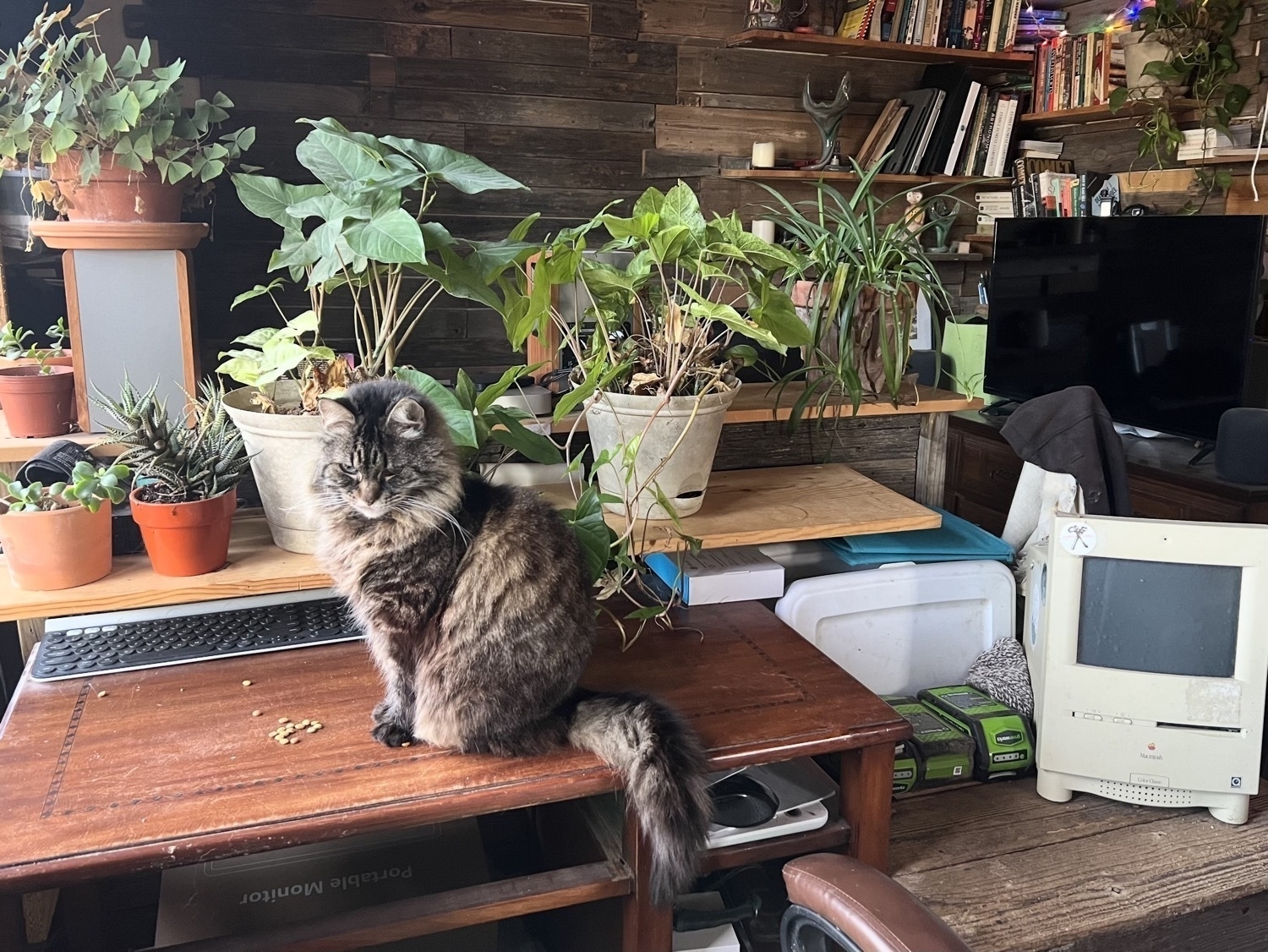
With these changes my small desk has more plants around it and is Rosie's dog-proof feeding area. The Mac Mini that is my file server/iPad back-up is in the same place and can be used with the monitor in its new location. The Mac Mini sits on the shelf/mini-wall between my desk and futon. My whole set-up is a bit weird but I attribute that to the fact that it's a one-room tiny house. It's nice though to walk into the cabin and see plants rather than a computer monitor.
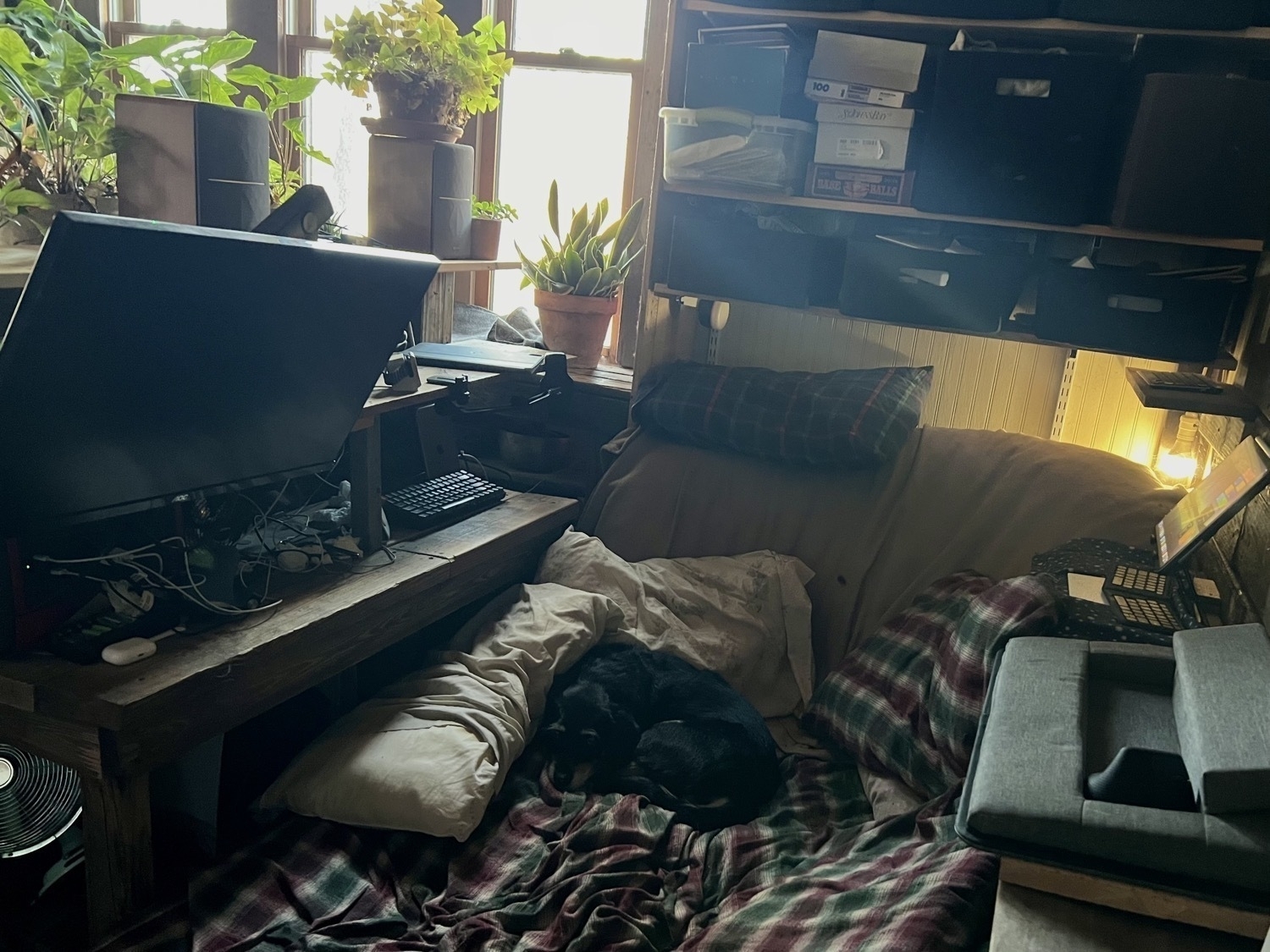
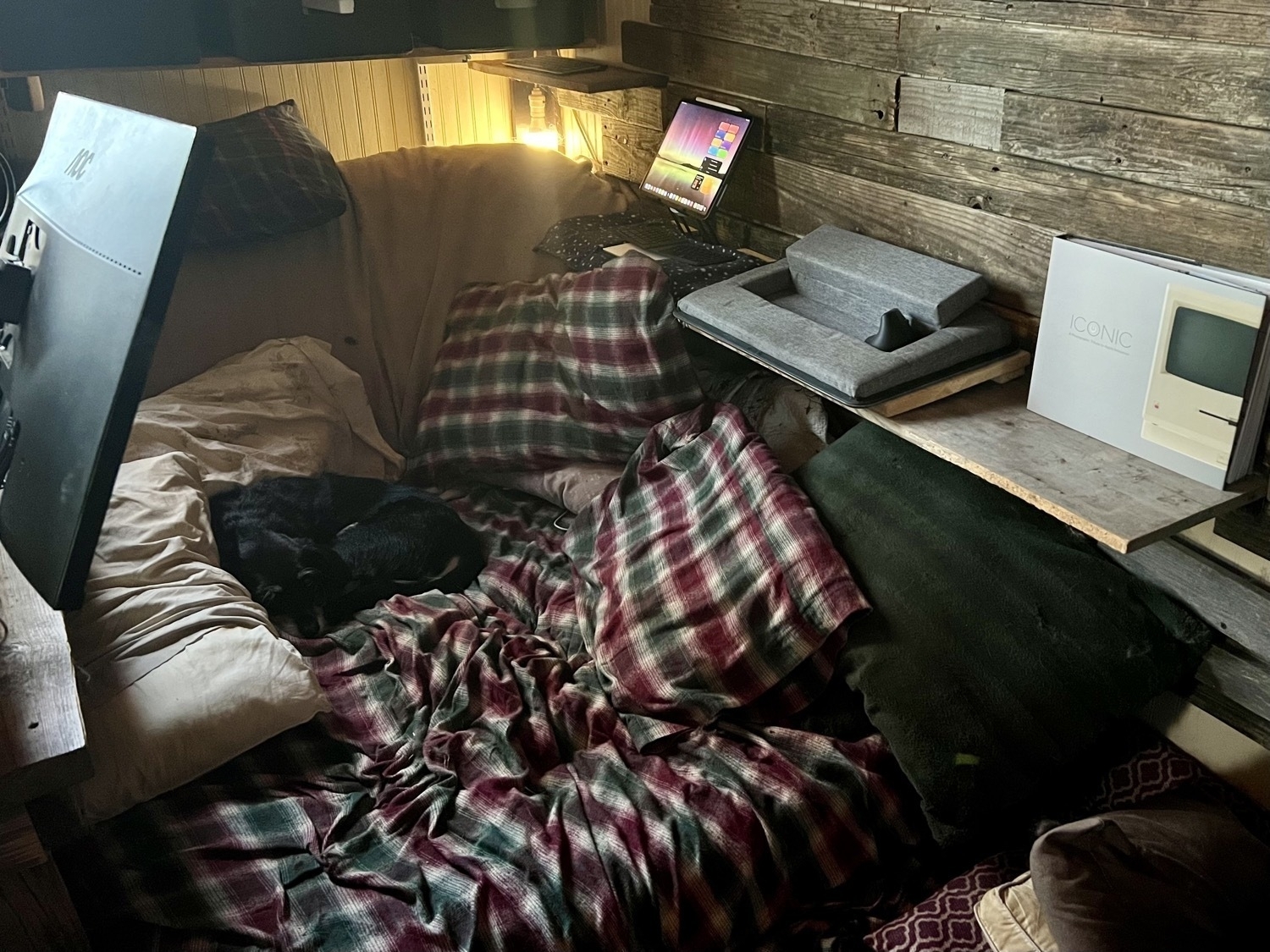 Some amazing iPad hardware is coming from Apple soon but I intend to stick with the M1 iPad as it works very well for what I need. It's only 3 years old this spring. It will likely need a new battery later this year.
Some amazing iPad hardware is coming from Apple soon but I intend to stick with the M1 iPad as it works very well for what I need. It's only 3 years old this spring. It will likely need a new battery later this year.
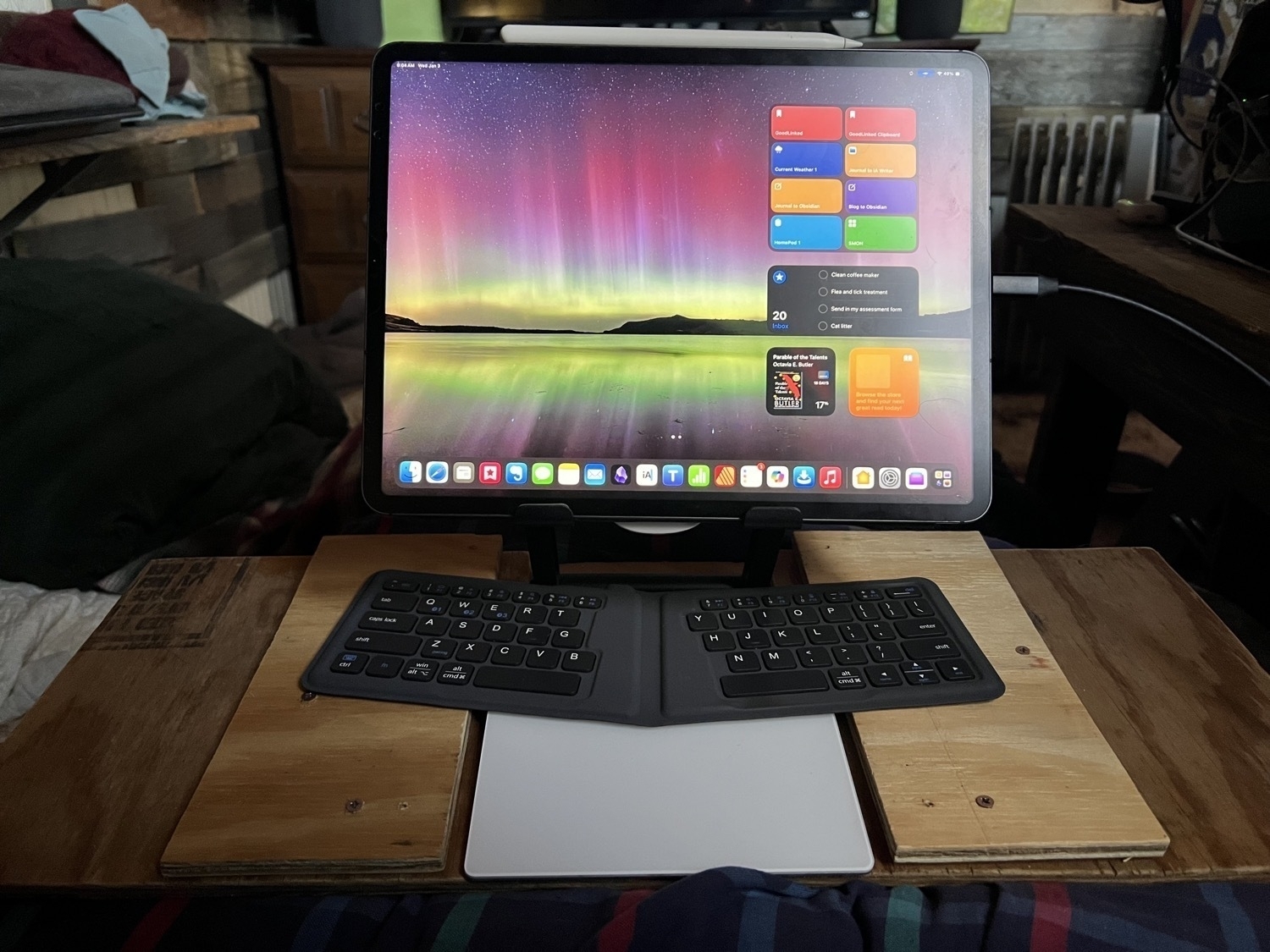
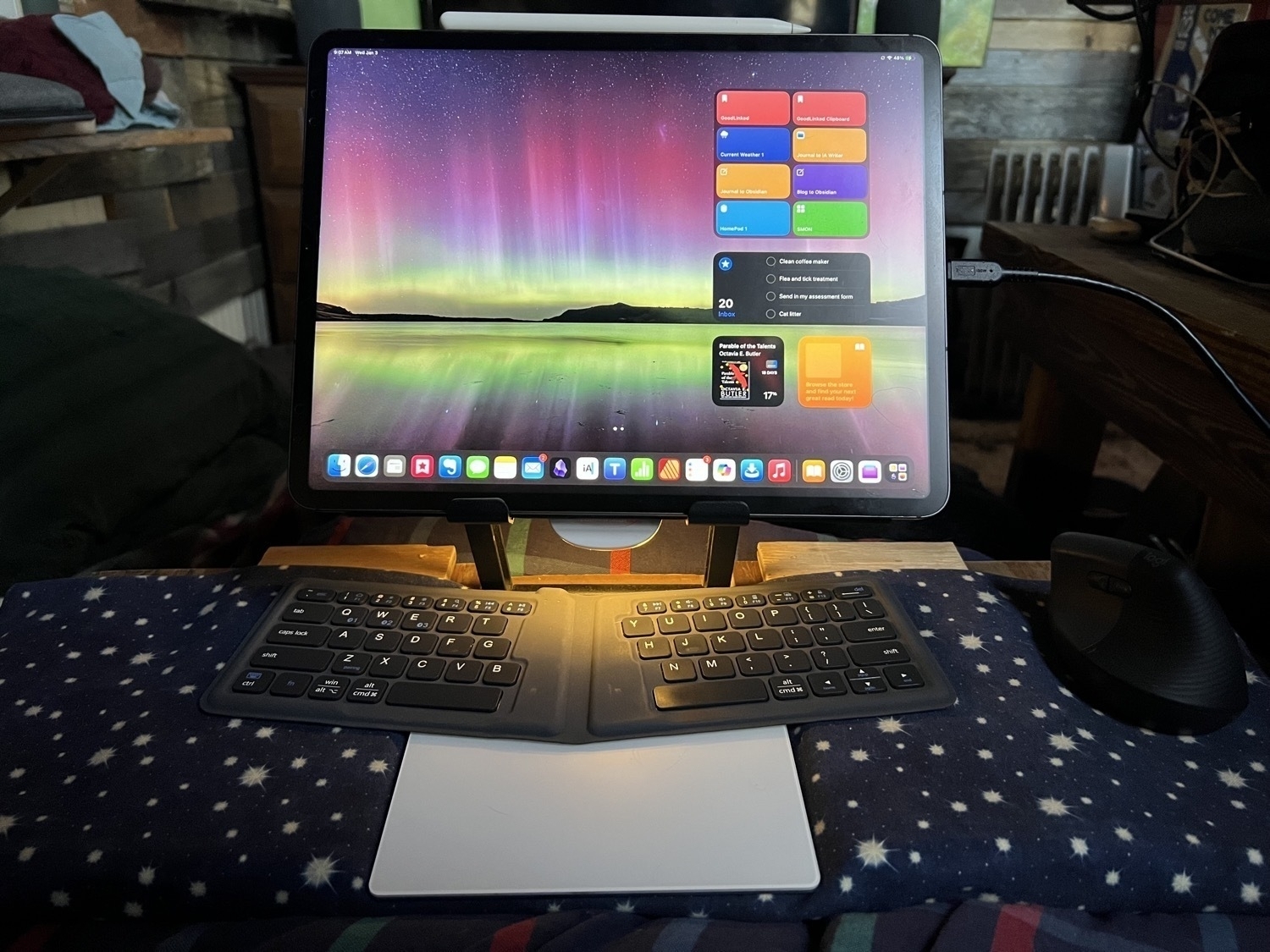
Over the past year I’ve enjoyed my various and ongoing configuration experiments. Just yesterday I modified my lap stand so that I can easily center my trackpad below the keyboard. By adding two small sideboards it’s now a recessed trackpad. Works perfectly and there’s plenty of room for the mouse to the side. In use I keep a pillow case on top for comfort.
Between this stand arrangement and having the adjustable shelf-clamped stand I have a variety of choices. A side benefit of this regular experimentation is that my set-up is fun and never feels stagnant.
My iPad Mini 5 and iPhone 13 both continue to work well and I expect to get at least another 3 to 5 years from both. The responsible thing is to use all of this hardware as long as I'm able and that's the plan. I want to appreciate not just the resources each device embodies but also to appreciate a kind of connection that comes with using a tool for a while. I expect I'll be able to get another year from my Appe Watch 4.
Among tech enthusiasts it seems fairly common these days to trade up to the latest, greatest fairly often. And so these valuable, powerful computers are being treated like disposable goods. Really, it's something that only a minority of the wealthiest and most privileged of humans can do and it's irresponsible. But also, it doesn't allow much room for the nostalgia that comes with long-term use. My 9+ years old iPad Air 2 still works and is put to use to run the DarkNoise app and occasionally for photo slide shows.
All that to say that I've been very happy with the over-abundance of computer/tech hardware that I have.
Image of one corner of the interior of my tiny house, 2024-01-03.
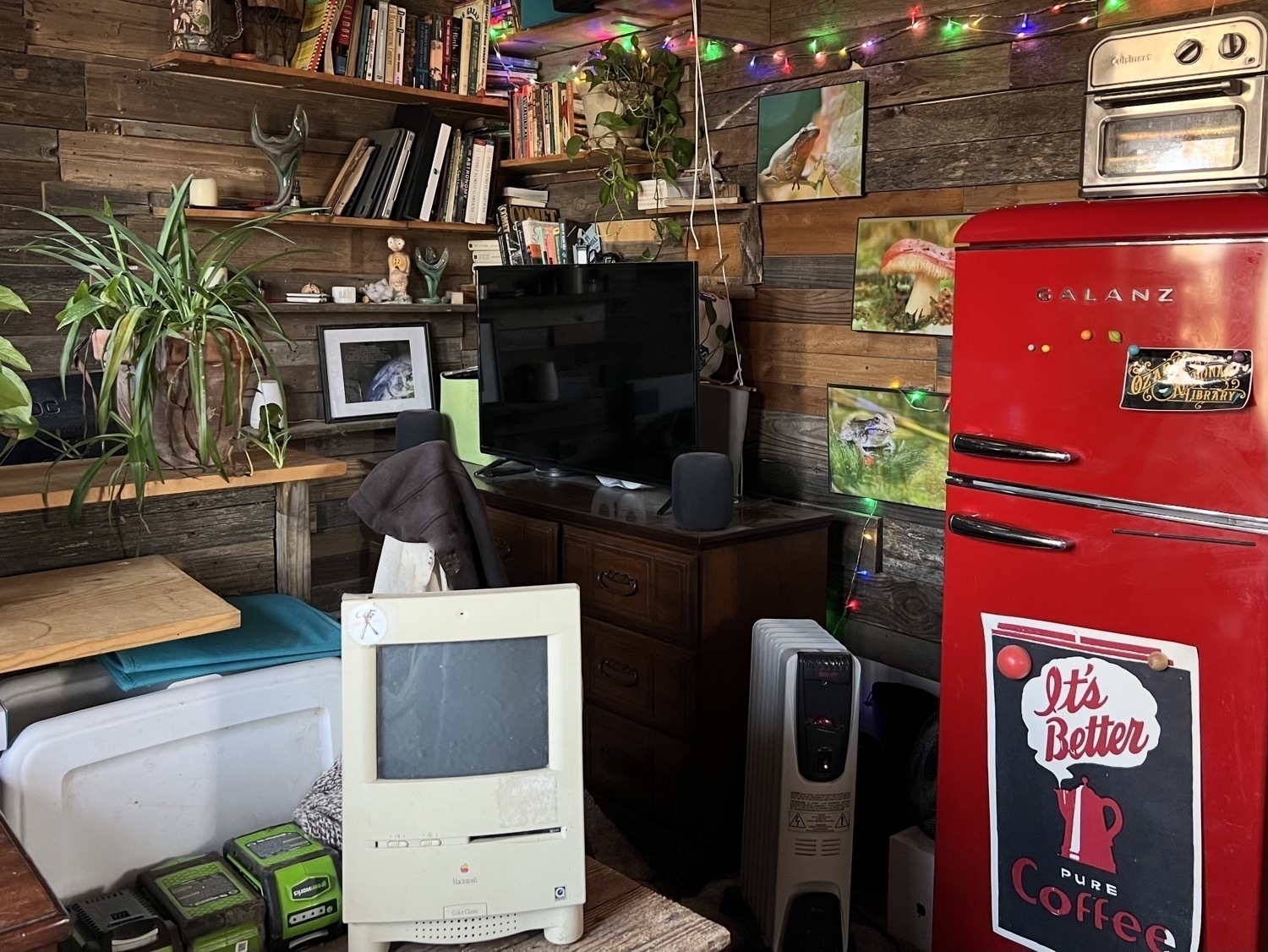
192 Square Feet: Part 3
Previously: Part 1, Part 2 I shared about the first year of my tiny house life. Building the tiny house, setting up the garden and food forest during the first summer. Then, of course, learning about living in the tiny house during winter and what that means for keeping warm and keeping things working.
The following spring and summer were spent extending the garden, building a chickencoop-greenhouse and raising chickens and guineas, and setting up a bee hive. Oh, and some local farmer friends brought me an orphaned fawn. We also built the kids’ cabin, the third cabin, for Kerry and Greg’s kids. A wild goose showed up mid-summer and adopted me.
The chicken coop greenhouse came first for practical reasons. I needed a place for the young chickens! The idea was to have the two attached. In theory the greenhouse would help keep the chicken coop warm in the winter and the proximity of the coop to the greenhouse also made sense in terms of composting the chicken coop straw bedding that was full of chicken poop. I could haul the straw just 25 feet to a compost pile between the greenhouse and the garden.
Then the bees which were set-up in their new hive in late April. More about beekeeping an a future post. All went as planned. Until it didn’t.
Petunia the deer came to live with me in early June after a new farmer friend. Luckily we had a safe, enclosed area for her. More photos of her in another post.
I also set up 6 rain barrels on a frame behind my cabin. Each barrel held 50 gallons and they were upside down with a PVC pipe connecting them all via the built in screw lids. This arrangement allows the barrels to all fill at the same time because they are filling from the bottom up. The photo below was taken before everything was finished so the run-off was a haphazardly arranged salvaged gutter that carried water to my swale which was mulched and planted with pawpaws and rhubarb a well a a few herbs.
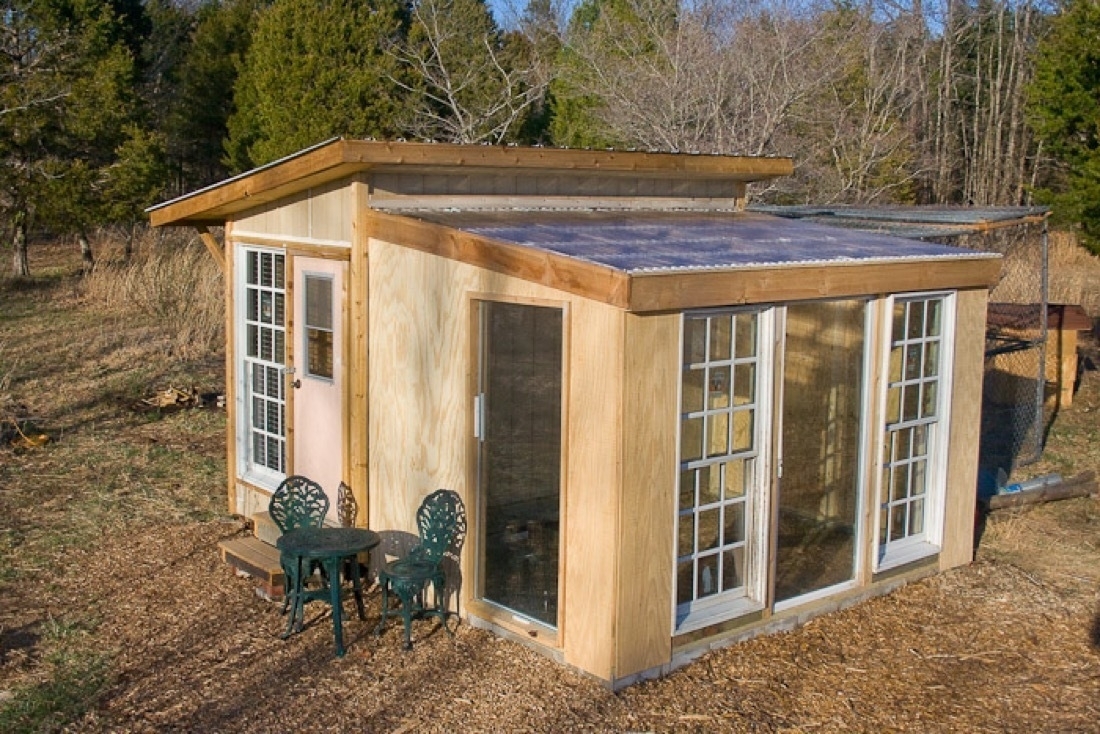 The newly finished chicken coop greenhouse.
The newly finished chicken coop greenhouse.
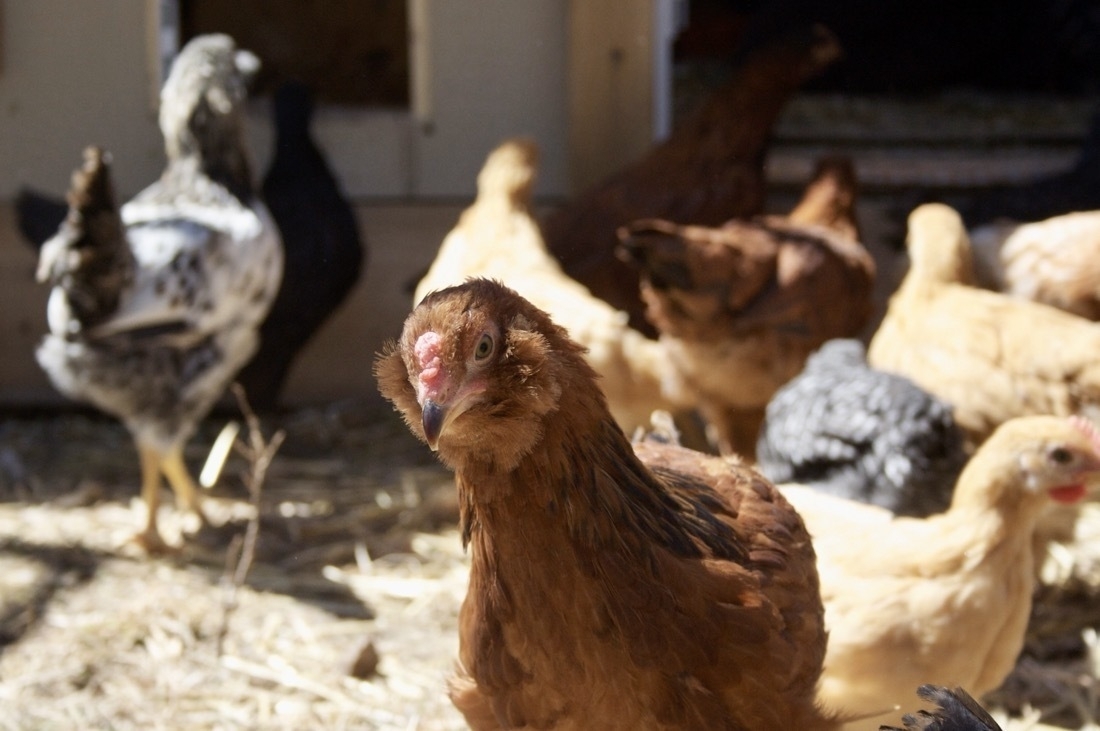 Happy chickens!
Happy chickens!
 Setting up the new bees in their hive.
Setting up the new bees in their hive.
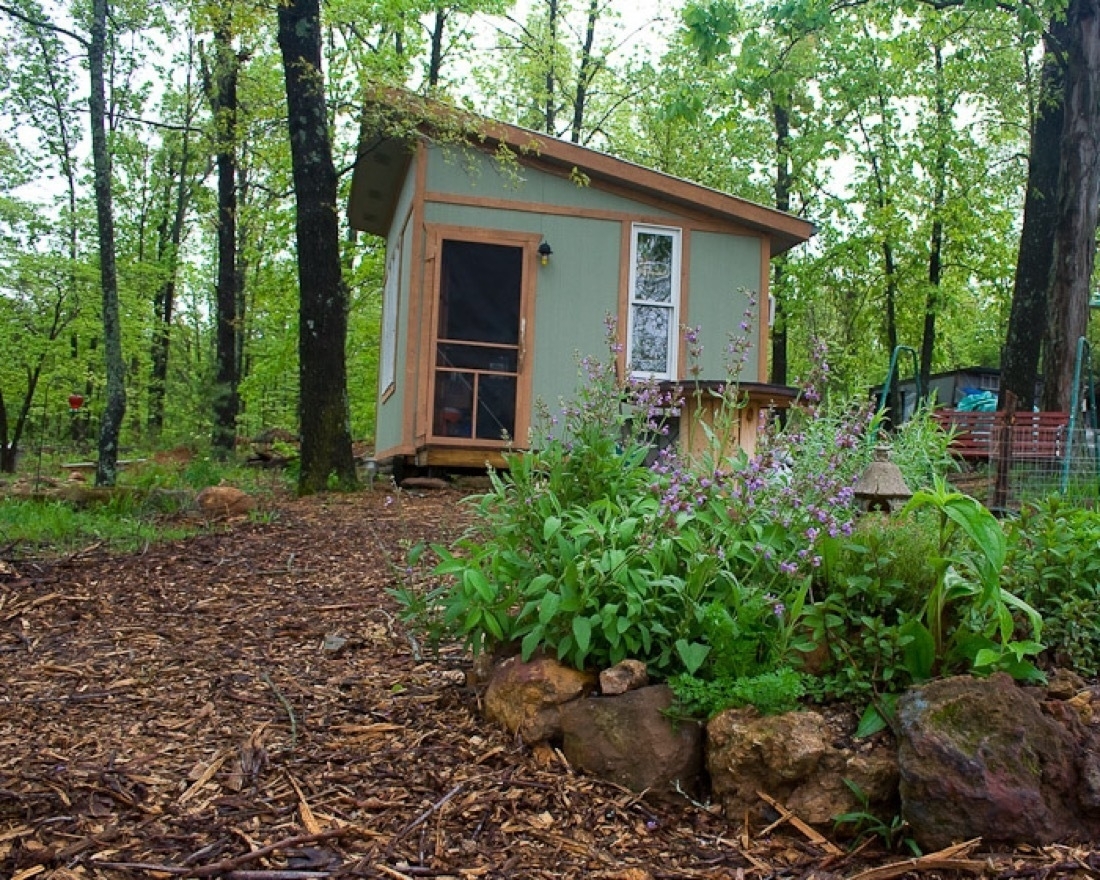 Herb spiral bed in front of my cabin.
Herb spiral bed in front of my cabin.
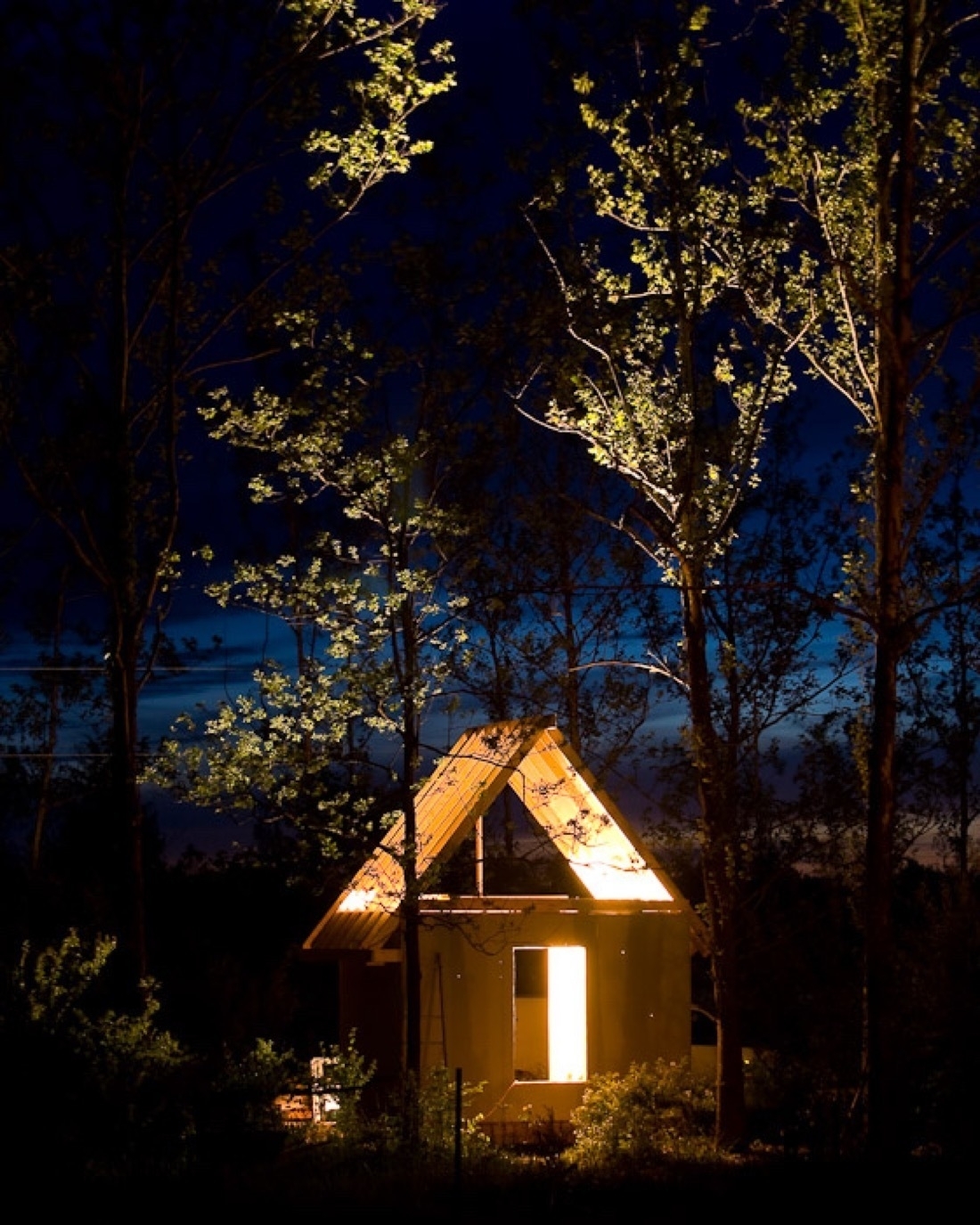 The kids’ cabin before the roof
The kids’ cabin before the roof
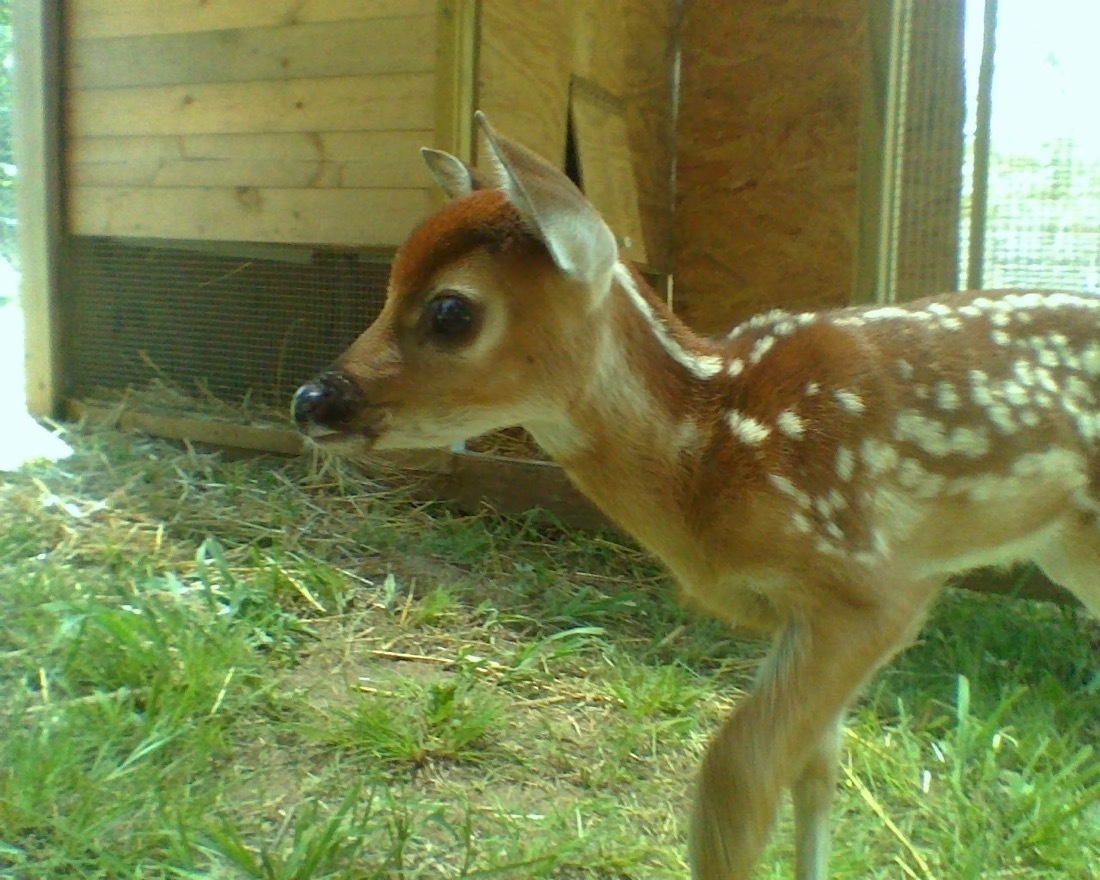 Petunia moves in
Petunia moves in
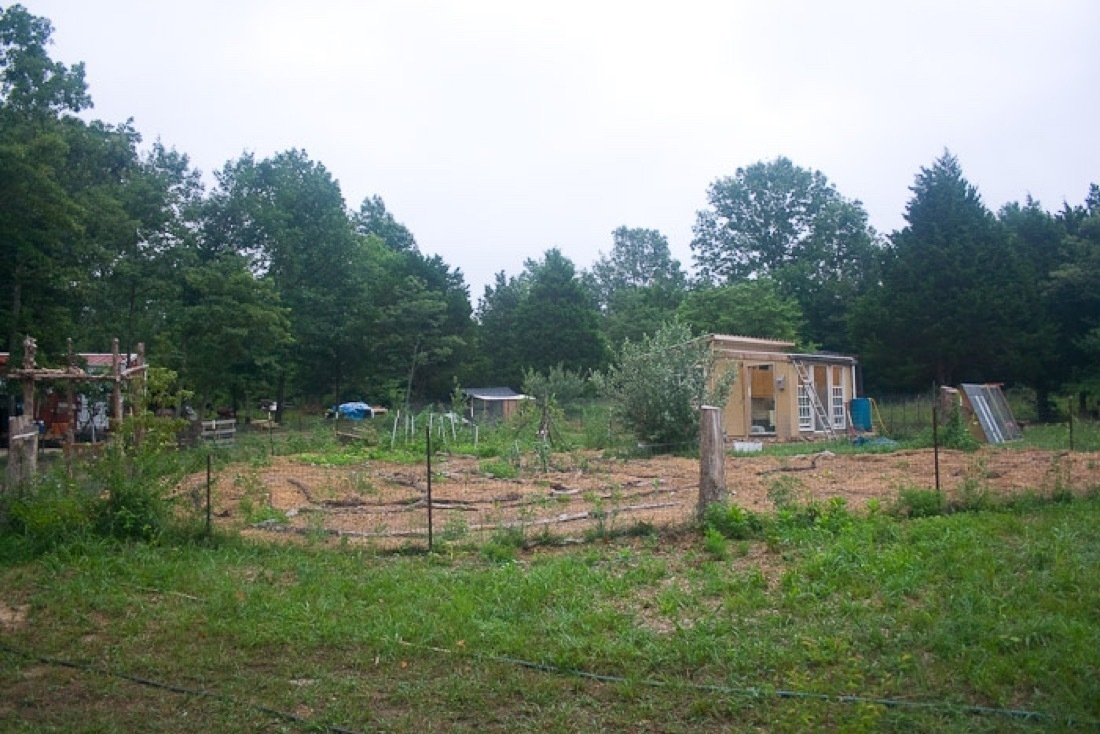 The spring kitchen garden, fully fenced in and mulched with cardboard and straw
The spring kitchen garden, fully fenced in and mulched with cardboard and straw
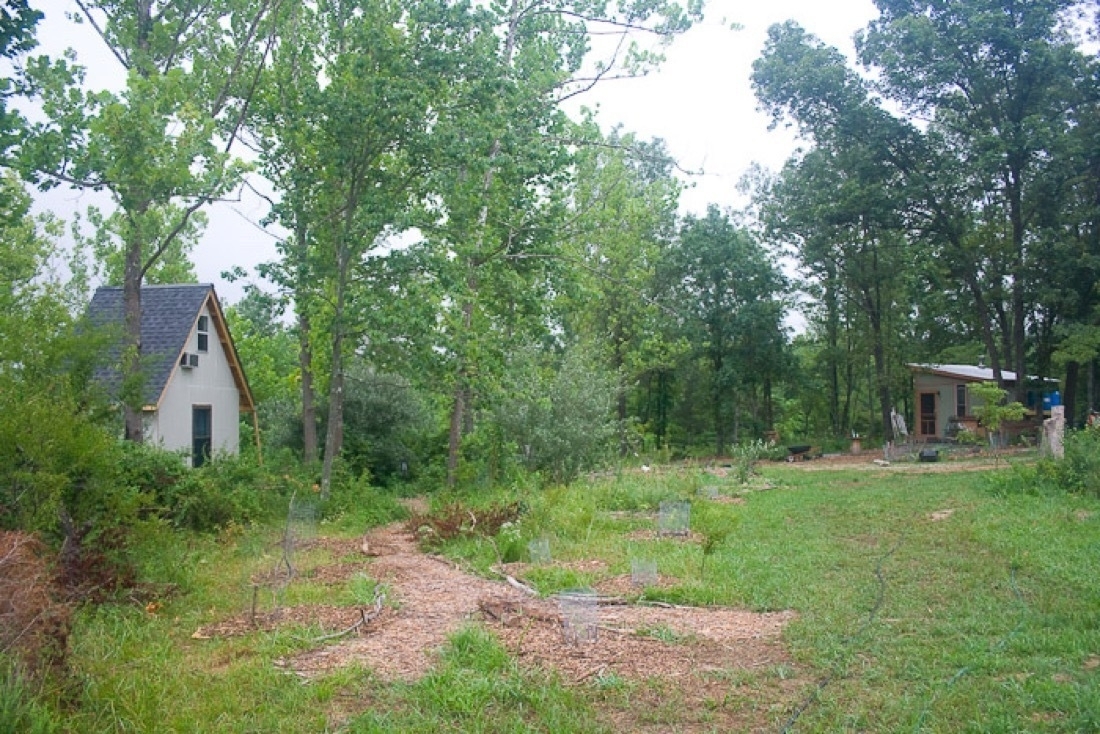 Mulched paths taking shape!
Mulched paths taking shape!
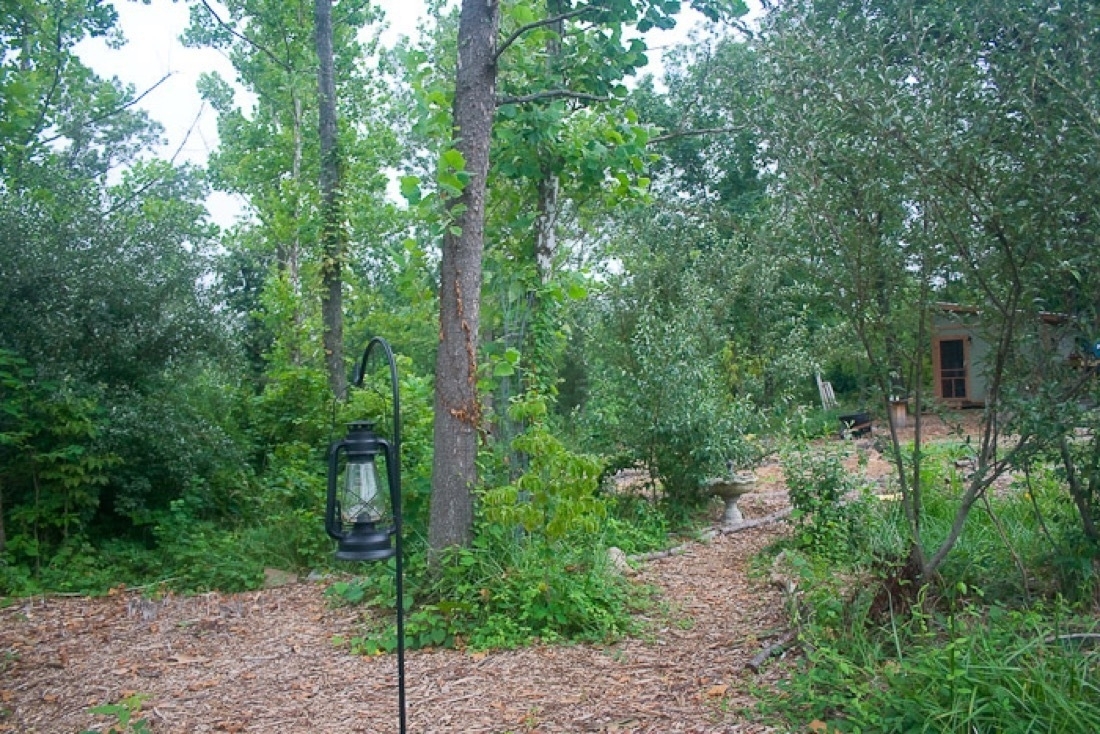 Paths
Paths
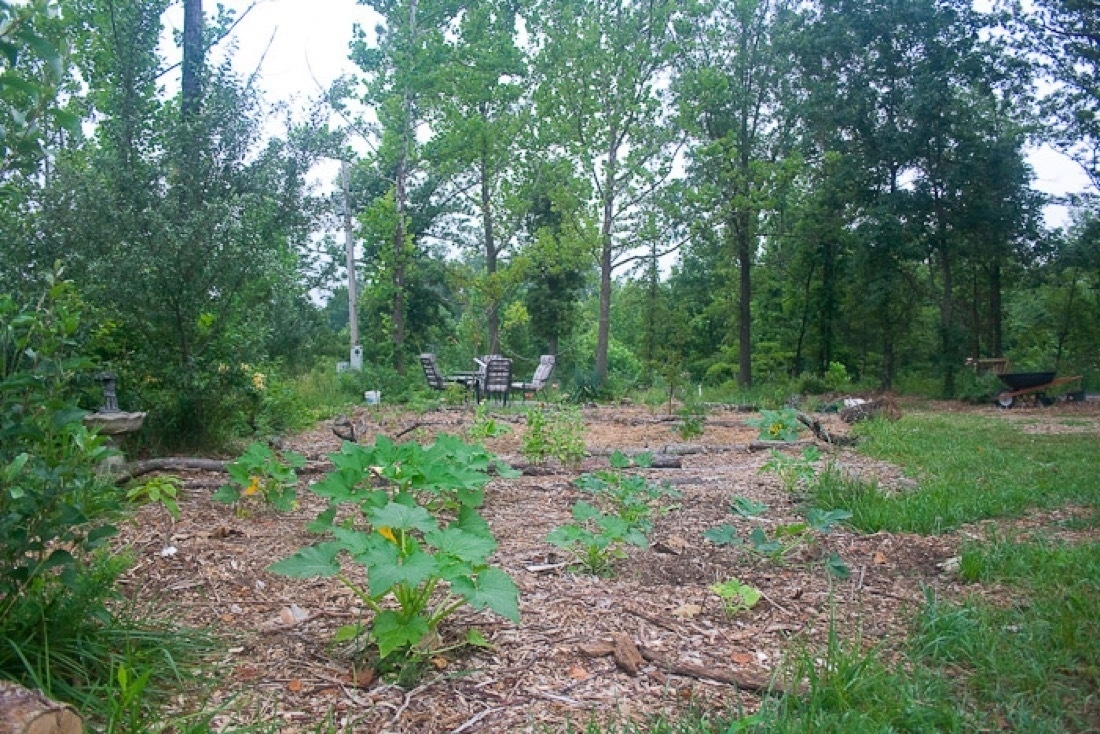 The early food forest interplanted with squash
The early food forest interplanted with squash
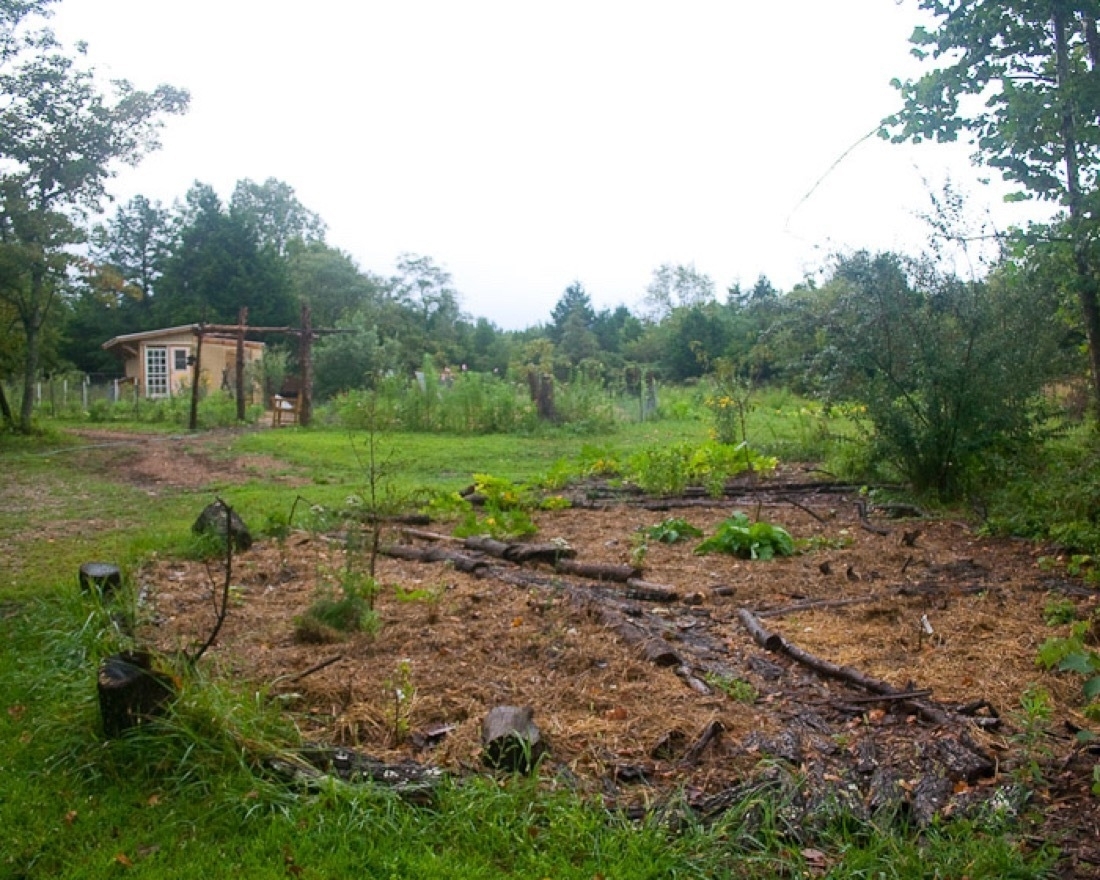 The food forest in front of my cabin with a mix of peaches, plums, gooseberry, currants and comfrey. Mulch with straw between small seedlings. Paths are defined by small logs and covered in bark and wood chip mulch.
The food forest in front of my cabin with a mix of peaches, plums, gooseberry, currants and comfrey. Mulch with straw between small seedlings. Paths are defined by small logs and covered in bark and wood chip mulch.

True story: Loretta the goose showed up one day in the summer and followed me to the outhouse which is back by the chicken coop. As I’m the only one here full time I leave the outhouse door open while doing my business as it’s a nice view. Well, this goose follows me up into the outhouse (3 steps) and proceeds to turn around to face outward and sits down on my feet. I almost died right there. When it was time to go I stood up and she did the same and then she stepped out ahead of me and followed me back to my cabin. And that was that, I’d been adopted by a Canada Goose. She spent the rest of the day hanging out around my cabin and left at sunset. I didn’t know if she’d be back but hoped she would.
She was back the following morning and spent the day with me. She just hung around outside the cabin, near the little pond I’d made for the frogs. At sunset she flew away. This was the daily routine for the next couple of months. She’d follow me around as I did my chores during the day and occasionally take a dip in the pond. There were times when I’d be doing chores and there would be a line behind me: the chickens, Petunia the deer (who was now free ranging) and Loretta the goose. On at least one occasion when I had guests over for dinner outside she stayed later than normal and as we stood/sat around a little fire after eating she stayed next to me making her various adorable little utterances. It seemed to me that it was her way of being in the conversation.
In late November or early December we had a few cold nights and the lake started to freeze over. As far as I could tell she didn’t spend any time in the lake but it seemed to be a cue to her. She flew off one evening and I never saw her again. I loved her and I still miss her.
 The mostly completed kids cabin
The mostly completed kids cabin
 Cutting up a cantelope with my niece, Emma
Cutting up a cantelope with my niece, Emma
 Rain barrels and swales collecting rain in the food forest behind my cabin. The system wasn’t complete when the photo was taken hence the crazy arrangement!
Rain barrels and swales collecting rain in the food forest behind my cabin. The system wasn’t complete when the photo was taken hence the crazy arrangement!
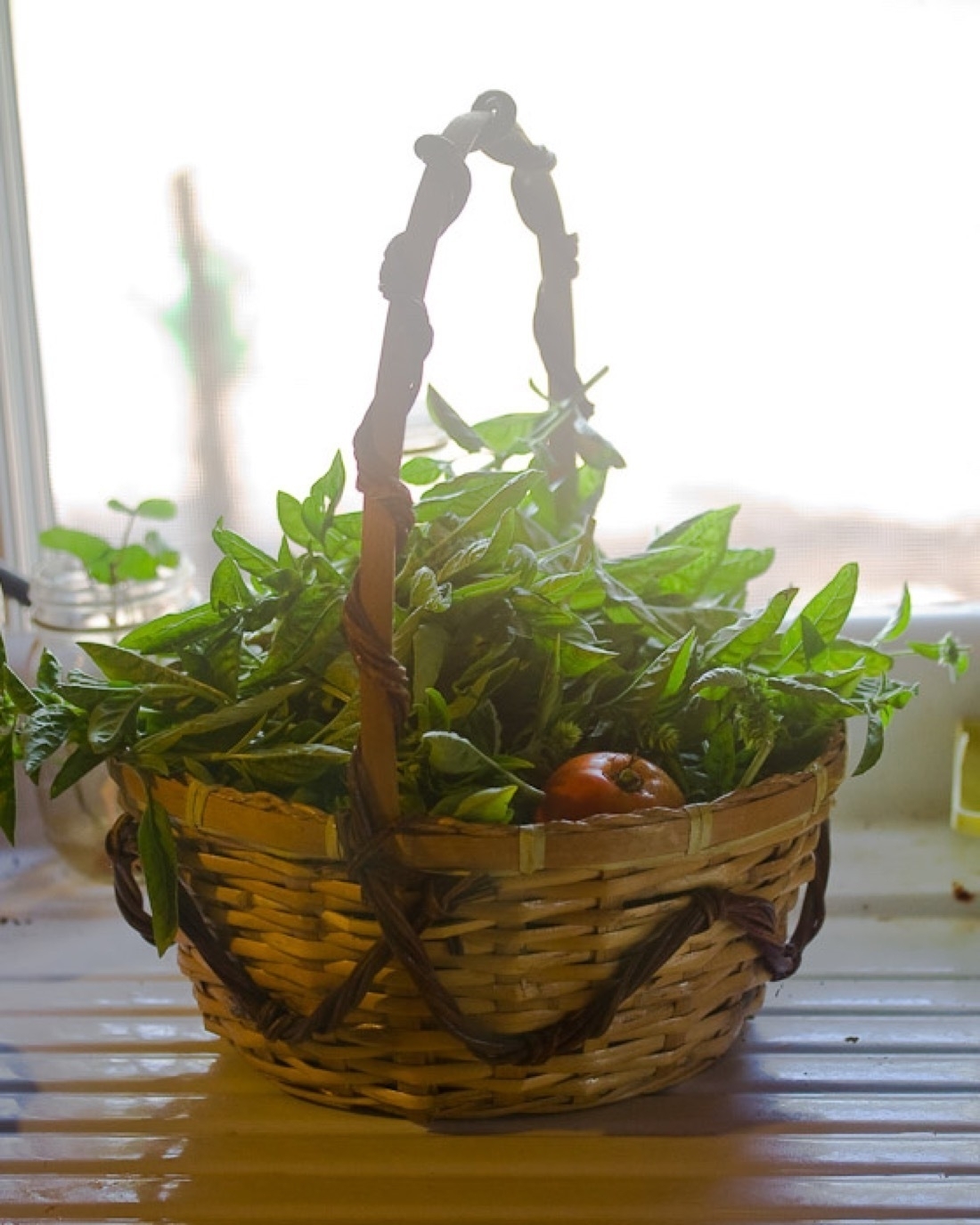 A basket of tomatoes and basil
A basket of tomatoes and basil
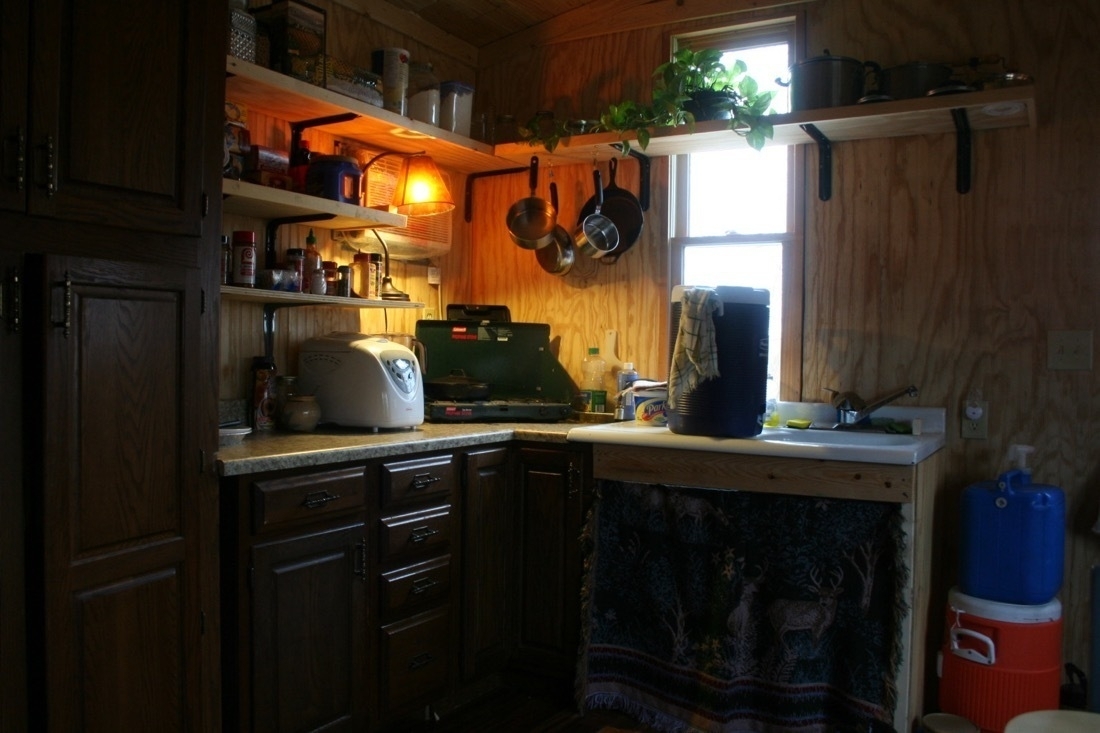
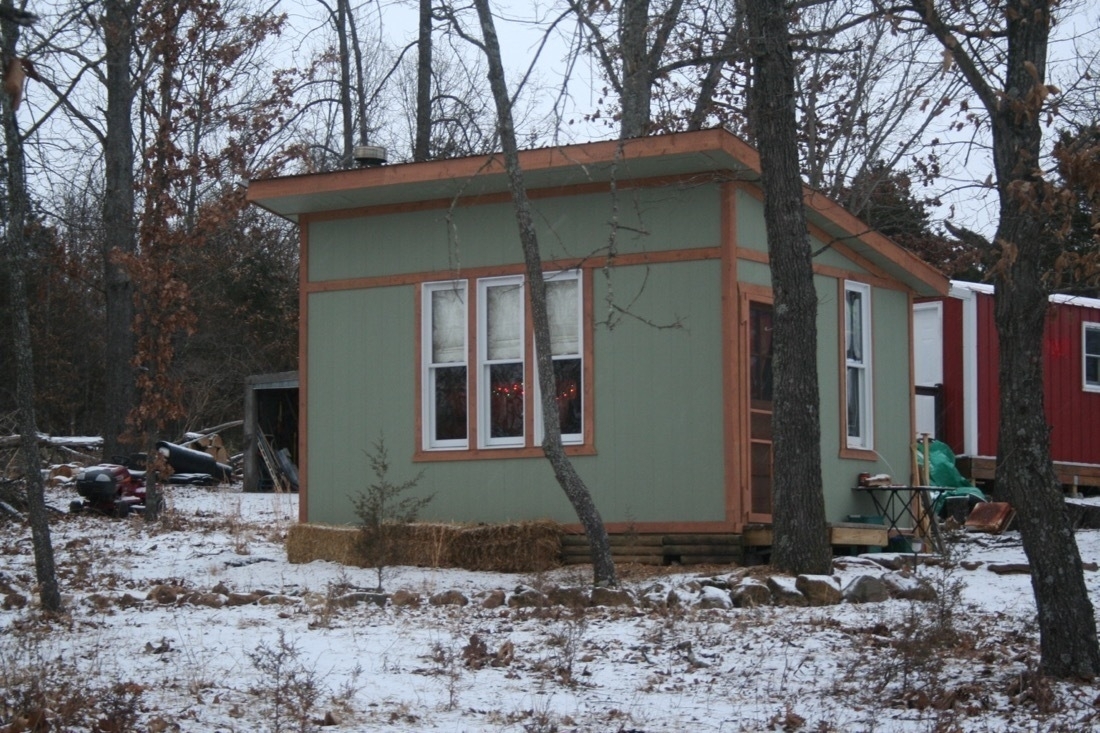
In 192 Square Feet Part 2 I wrote about my first winter living in my tiny house. Keeping warm with a wood stove without being too hot or too cold was difficult in a small space. Also, winter water challenges!
An older post from 2016 about the process of building my tiny house and the first few months living here. 192 Square Feet
A small, energy efficient laundry machine for a tiny house or other small space.
In the early 90s there was a television show called Northern Exposure and in one episode one of the characters was debating getting their own washing machine. They were resistant because they enjoyed the social aspect of going to the neighborhood laundromat. Why use natural resources for a tool that could be had in a communal setting? As a conservation-minded, community-oriented activist that resonated with me.
Fast forward to 2022 and I’ve been living in my tiny house for 12 of the last 14 years and it was only yesterday that I finally did a load of laundry in my own washing machine. In previous years I either used a laundromat in town or I’d wash when I visited with my folks who are also nearby neighbors.
I’ve thought off and on of getting my own washing machine but in a small tiny house the choices are limited. My folks are planning to move and rather than automatically revert to a laundromat in town I went looking again to see what might have changed since I last looked over a decade ago. I was surprised to find that there are now fairly small top loading washing machines optimized for small spaces. They come in several sizes but in general, compared to a standard washing machine they’ll do a small to medium load. I decided to try one of the larger options in the hopes that I’ll be able to wash a small blanket when needed.
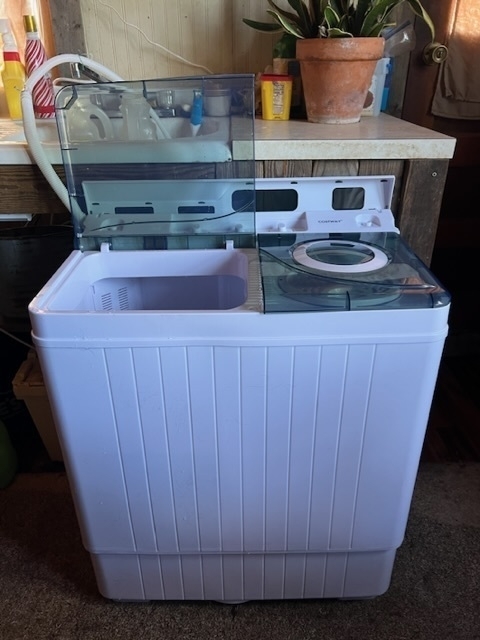
I’ve only done one load of laundry but thought I’d offer up a mini review. Obviously this doesn’t speak to the longevity or durability but I think I can comment on the effectiveness and usability . The machine I purchased has left and right sections. The left side for washing will take up to 18lbs and the right side for “drying” via a spin cycle takes up to 8lbs at a time. I did a medium load with was pretty typical for what I need to do: a few hand towels, wash cloths, socks, a couple pillow cases, a couple t-shirts, a sweatshirt, padded cycling shorts, and some underwear. I could have done a full load and added in a towel or a few more t-shirts. I’ll have no problem doing a full-sized sheet and a few clothing items. A small blanket should be fine to wash, not sure if it will fit in the spinner.
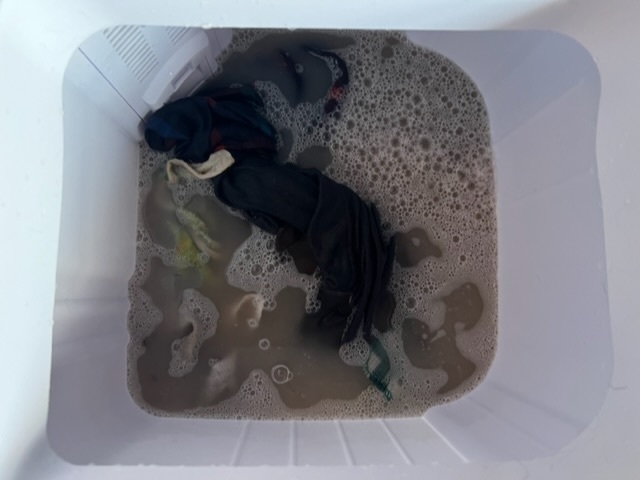
Some of these machines drain via gravity and require that the hose be level with the machine to drain out the water. The machine I bought has a pump and so the hose can be elevated to a sink to drain. I did a 10 minute wash cycle with soap then drained it and did a 10 minute rinse. The machine offers a forceful, efficient movement of the water during the washing process. The water after the soap cycle was obviously dirty and the water after the rinse cycle was clear. I divided the load into 3 for 3 different 3-4 minute spin cycles. The result was exactly what I hoped for: clean stuff that was fairly dry. Given the colder weather I hung most of it up to dry on a clothes line in my tiny house.
These are fairly energy efficient, maxing out at 280 watts so could be used with a solar/battery off grid system without too much drain for an average load. Assuming it holds up for several years I’ll consider it well worth the $200 cost.
Solar punk tiny house! Flowers in foreground: Vernonia baldwinii, the western ironweed is the purple flower. Rudbeckia subtomentosa, sweet Coneflower is the yellow.
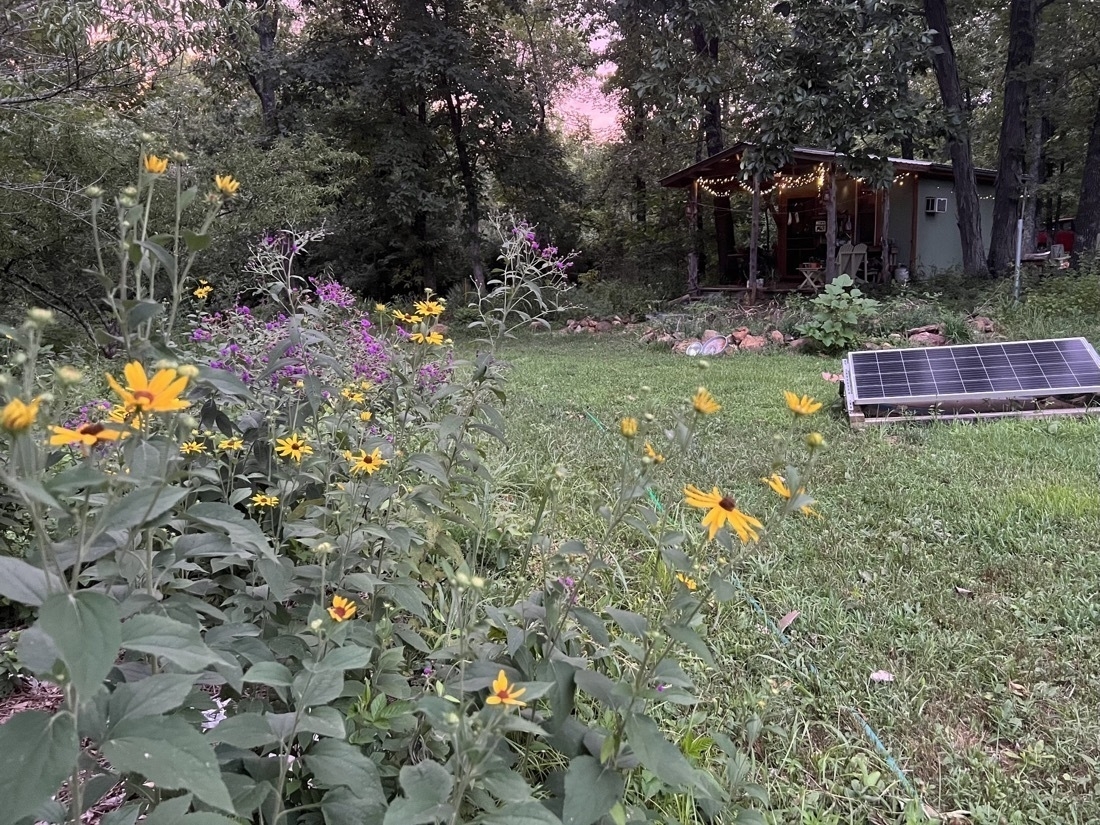
Kitchen Appliances
I’m generally not all that excited by kitchen appliances and this post is no exception. But in the past 3 years I have added three useful appliances to the tiny house “kitchen”.
In the first couple years of living here I had no fridge of any kind. And surprisingly, it is possible to get by without one. It’s easier without meat in the mix. In 2016 I added a small, mini fridge and at some point after that I started keeping a few things in the freezer that is in my sister’s cabin. This past year I decided to get my own fridge/freezer combination. I didn’t want a full size but I wanted something bigger than the normal mini fridge/freezer. After a bit of searching I found a 7.6 cubic foot “retro” Galanz refrigerator. And, for an appliance meant to keep your food cold/frozen, it’s kind of adorable. I’d never heard of the brand but it was the perfect size and I was lucky enough to get it on sale at Home Depot.
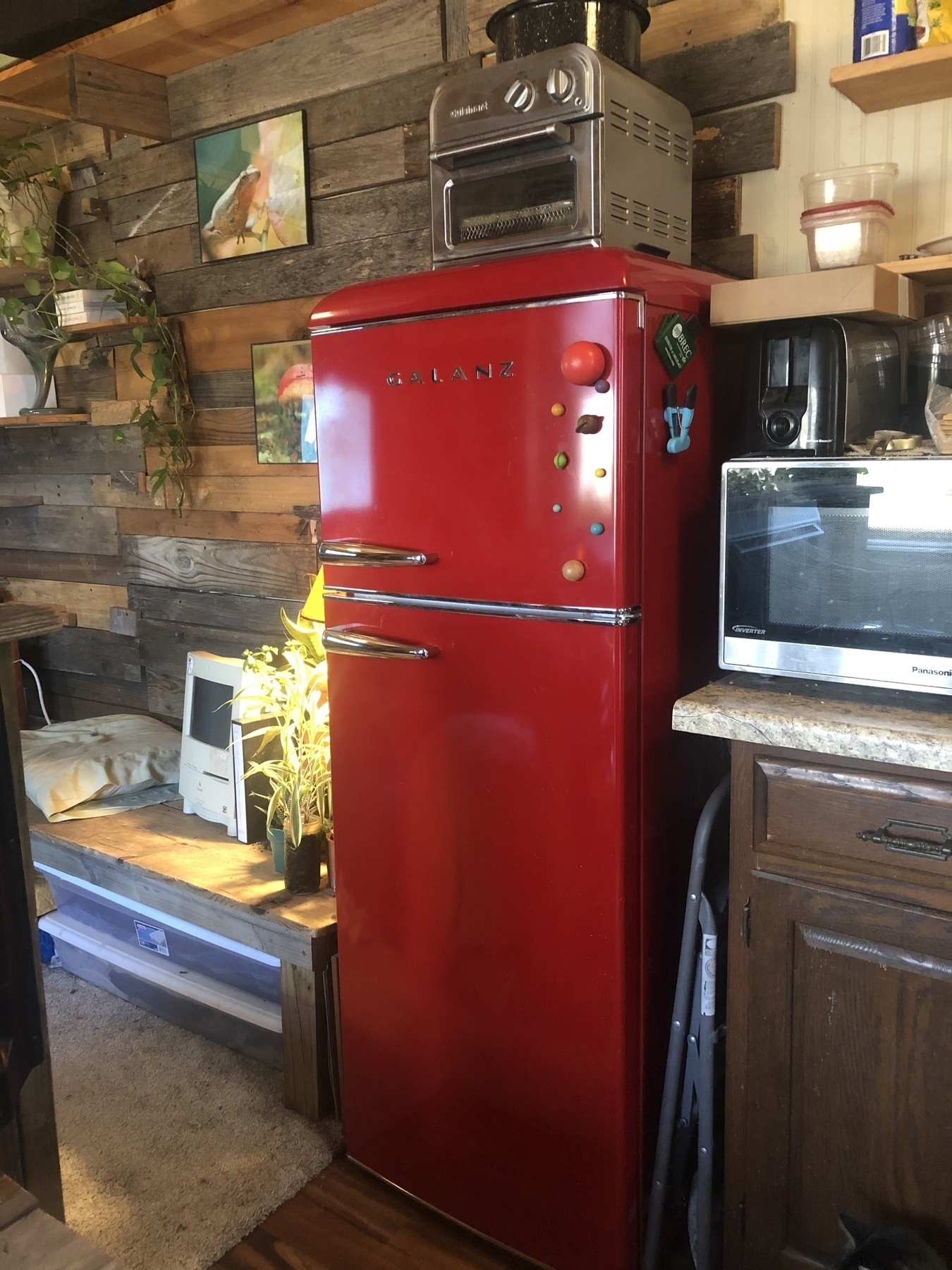
Next, is a small Air Fryer, the Cuisinart AFR-25. Generally my cooking is simple. I use a microwave or an induction (That’s next on the list). At some point in the past I also used a toaster oven with mixed results. After hearing my sister and her family rave about their toaster oven for months I finally bought one and it was a good choice. I use it almost daily. In the summer I use it outside on my deck to keep the cabin cooler. In the fall, winter and spring it fits perfectly on top of the fridge. Thus far I find it most useful for cooking veggie burgers, french fries and little pita pizzas. It’s like having a small oven. The french fries are just long-cut wedges, no oil needed so healthy. The pita pizzas are special treats, simple little pizzas made from pita bread, sauce and cheese. I still use the microwave but this is better for things that benefit from being crispy or for “baking”.
Last would be the induction countertop burner. Around $50 and it’s good. The one critique I have is that parts of the touch control labels wore off pretty quickly with cleaning. There’s enough still there that I can still use it but really, it would seem pretty important that those label indicators not wear off. In any case, it’s a simple, one burner induction stovetop that works very quickly. Great for making soup, pasta, or anything that requires a stove top. Easy to clean. Cooking goes much faster than using other methods and it’s pretty easy to control the temps. I’m sure there are better devices out there but this one has been fine in my experience. Glancing at the Amazon offerings, if I were buying today I’d possibly choose another though I’m not unhappy with this one. The point I’d make is that this type of stovetop is perfect for a tiny house.
My Tiny House Updates
I’ve been living in this 12x16 tiny house for over 11 1/2 years now! Well, no, I was gone for 2. So, 9 1/2 years technically. Which means, that this May marks my 10th year of living in the cabin. It occurs to me that I’ve not written any recent posts about the interior of the cabin which has changed a lot over the years. So, I’m working on compiling a few photos and thoughts about the changes from May of 2008 when I moved in to the most recent updates.
It also occurs to me that it would be fun to write-up a few brief reviews on a couple of the items I’ve found useful living in a tiny house. I’ll likely compile those into one post.
Old wood nooks, crannies and shelves
It’s been nearly a year since I moved back into my cabin and it’s been a good year of settling back into my place again. Much of what I’d done had been undone during my two years away but I’ve been busy making it my home. I had no intention of trying to return it to how I left it but thought something new out of available materials would be better. I had a good bit of reclaimed wood to use and that took care of about 60%. I did end up buying some trim boards as well as a few boards for shelving.
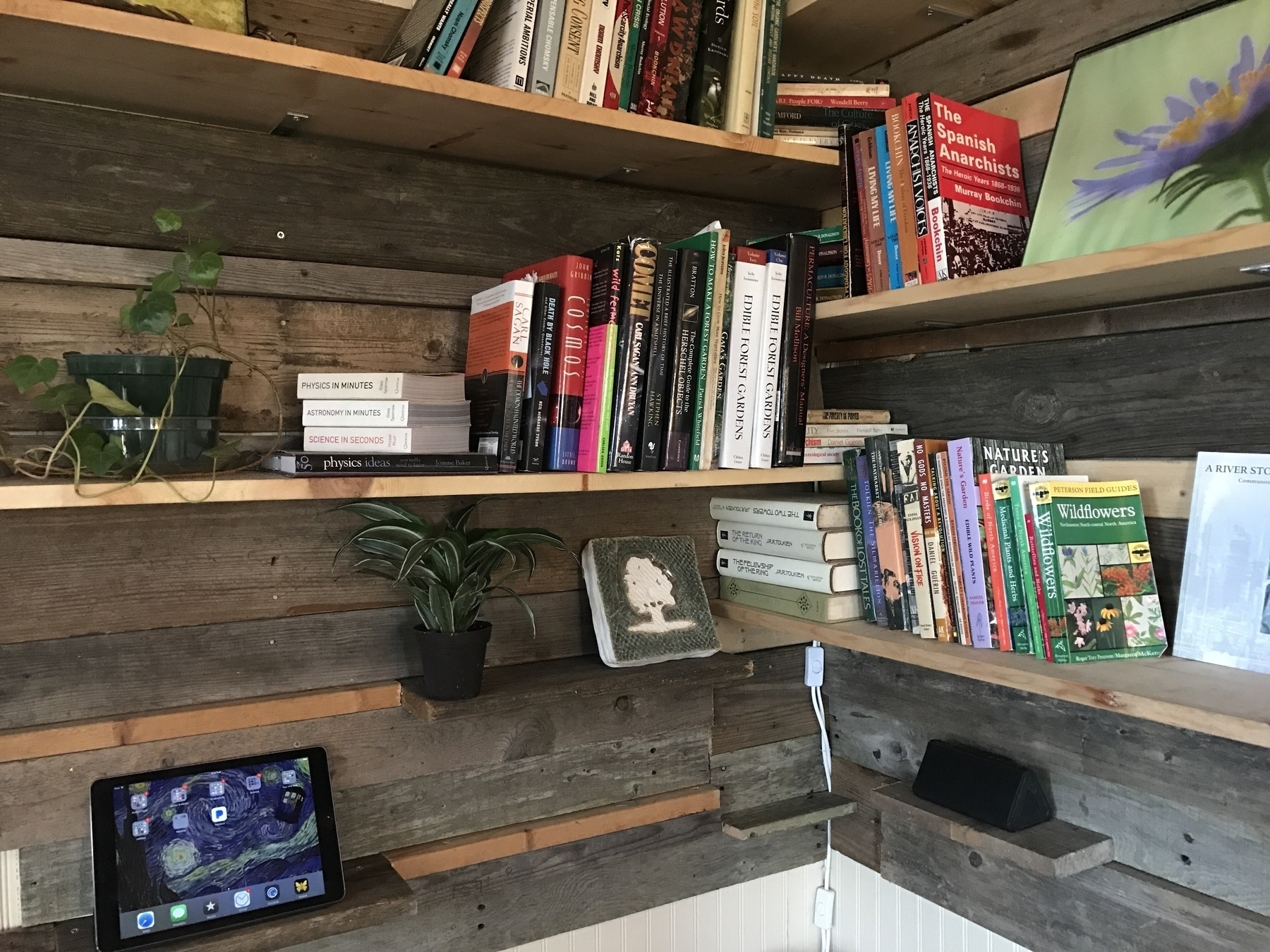
The above image is a corner of the cabin which started with some shelving on brackets but it looked naked so I used much of my reclaimed wood to warm it up a bit. It’s a mix of oddball sizes which resulted in a very cozy, dynamic surface with different depths. Even better, as I puzzle pieced it together I built in little shelves just deep enough for my iPad, candles, small potted plants, bluetooth speaker and any other oddly little thing that needs a temporary home. When I’ve had a chance to reclaim more old wood I’ll likely take it down another 14" so that it disappears below my futon.
192 Square Feet: Part 2
This is part two in a series. The first outlined the first seven months of building and living in a 192 square foot house that would be the first of several tiny structures on a property in Missouri.
My first seven months in the cabin felt a bit like camping and they were fantastic! As I went into my first winter I had the essentials: a warm, dry tiny cabin with electricity and wood heat. I did not yet have running water but I did have a sink that drained. For water I filled three 5 gallon tanks at our well 150 feet from my cabin. Most modern-day citizens of the U.S. wouldn’t want to do that for long as we’ve been raised with indoor plumbing which delivers fresh water out of a faucet. I welcomed the experience because I knew it was temporary and because I knew it was giving me a bit of perspective.
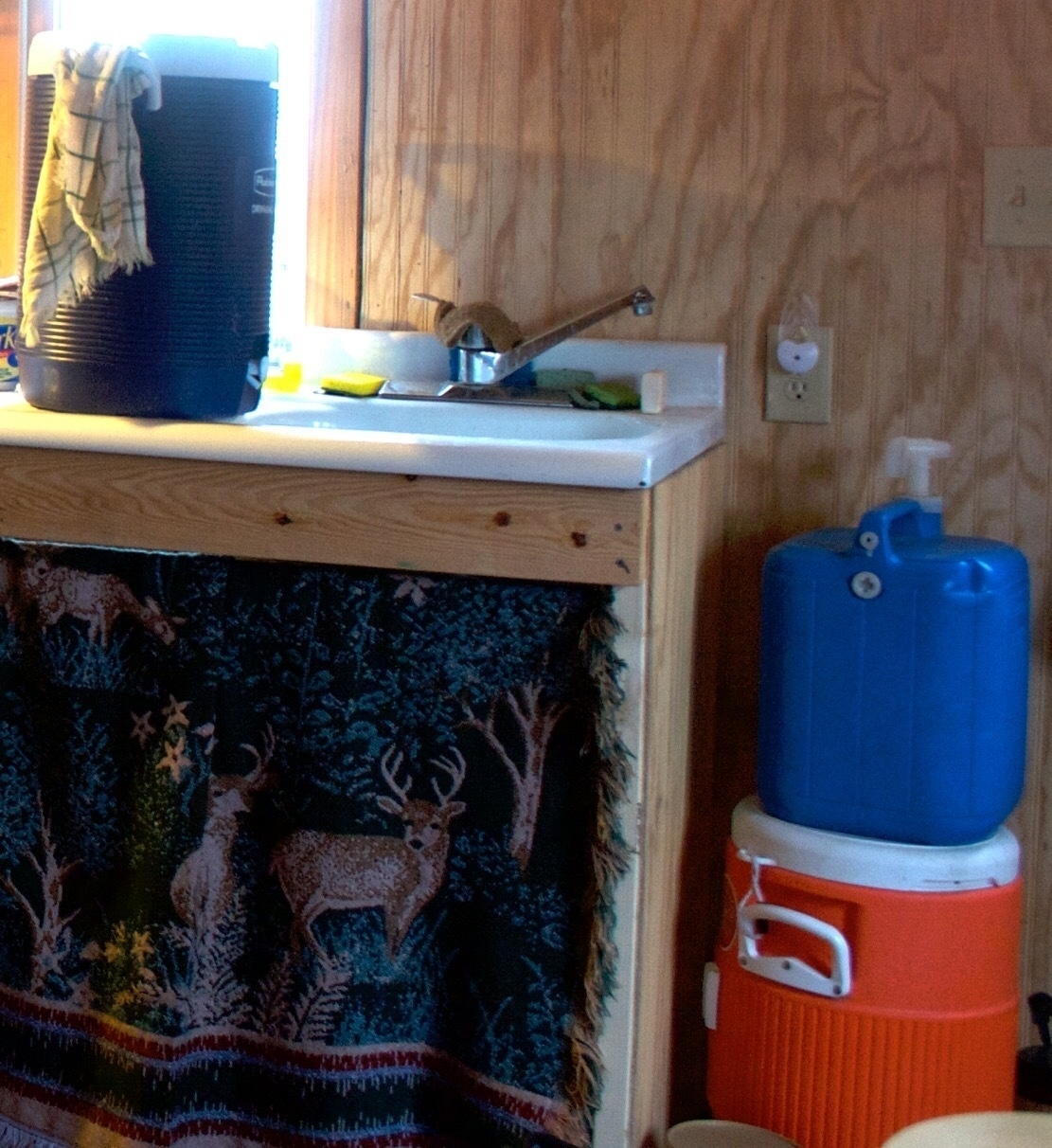 There are still some in the U.S. without indoor plumbing, mostly on Indian reservations and in rural areas. According to this story by the Washington Post the number, as of 2014, was 1.6 million Americans. According to a WHO/UNICEF 2010 report “3.8 billion people, or 57 per cent of the world’s population, get their drinking water from a piped connection that provides running water in their homes or compound.” If I needed to live for a year or so without water coming into my home I might get just a brief taste of what many others live without not by choice but by circumstance. But there’s more. Many of those that do not have a water line into their home also don’t have the convenience of a private, powered well with clean source of water just 150 feet away. I considered myself very fortunate.
There are still some in the U.S. without indoor plumbing, mostly on Indian reservations and in rural areas. According to this story by the Washington Post the number, as of 2014, was 1.6 million Americans. According to a WHO/UNICEF 2010 report “3.8 billion people, or 57 per cent of the world’s population, get their drinking water from a piped connection that provides running water in their homes or compound.” If I needed to live for a year or so without water coming into my home I might get just a brief taste of what many others live without not by choice but by circumstance. But there’s more. Many of those that do not have a water line into their home also don’t have the convenience of a private, powered well with clean source of water just 150 feet away. I considered myself very fortunate.
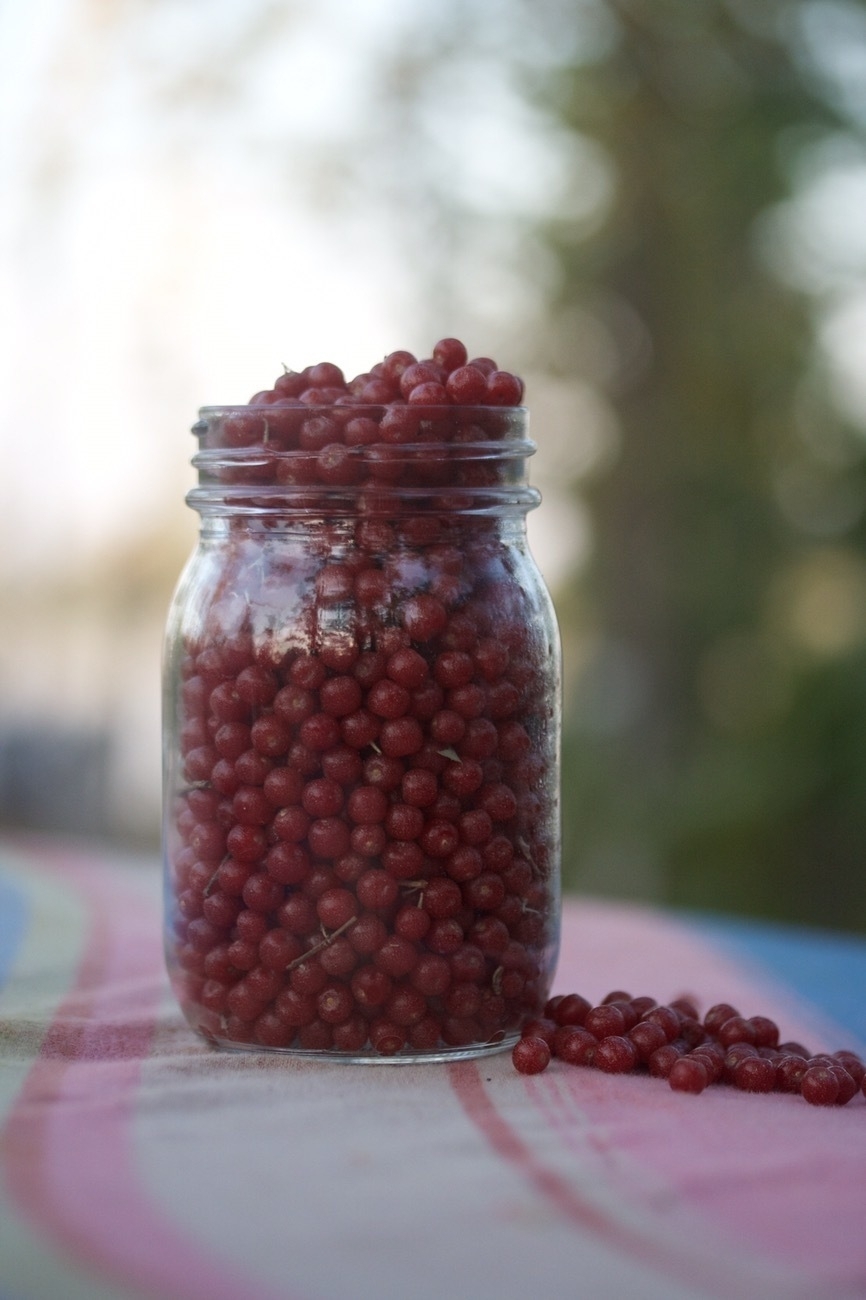 In October and November I put the garden to bed with planted garlic bulbs and lots of mulch all over. Mostly I used cardboard and straw. I mulched over paths as well as beds and areas of grass that were to be expanded garden beds in the spring. An unlooked for but happily discovered fall crop was the Autumn Olive! We have many of them in the area and the bushes not only smell wonderful in the spring but bear huge amounts of tiny red fruit that are not only edible but a real treat once fully ripe!
In October and November I put the garden to bed with planted garlic bulbs and lots of mulch all over. Mostly I used cardboard and straw. I mulched over paths as well as beds and areas of grass that were to be expanded garden beds in the spring. An unlooked for but happily discovered fall crop was the Autumn Olive! We have many of them in the area and the bushes not only smell wonderful in the spring but bear huge amounts of tiny red fruit that are not only edible but a real treat once fully ripe!
 Heating with wood that first winter worked pretty well but in a small space even a smallish woodstove can be difficult for full time heating. What I discovered was that it was very easy to waste wood because it was very easy to heat the cabin too much. With so little thermal mass the cabin would heat quickly and cool quickly. I would put a couple logs in at the start of the day and every couple of hours add another log or two. If I was very careful I could moderate it but the slightest miscalculation meant the cabin was suddenly 85 or 90 at which point I could suffer through it so as to not waste the heat or I could open a window or take a walk, either way I was “wasting” the heat and wood. At bedtime I would put a log or two in and know that I would need to get up in two or three hours to put in more. If it wasn’t too cold I could let the fire go out and start fresh in the morning. I woke up many days to my inside thermometer reading between 45 and 55. Certainly tolerable but not very cozy. This would be an issue I would have to deal with in the future.
Heating with wood that first winter worked pretty well but in a small space even a smallish woodstove can be difficult for full time heating. What I discovered was that it was very easy to waste wood because it was very easy to heat the cabin too much. With so little thermal mass the cabin would heat quickly and cool quickly. I would put a couple logs in at the start of the day and every couple of hours add another log or two. If I was very careful I could moderate it but the slightest miscalculation meant the cabin was suddenly 85 or 90 at which point I could suffer through it so as to not waste the heat or I could open a window or take a walk, either way I was “wasting” the heat and wood. At bedtime I would put a log or two in and know that I would need to get up in two or three hours to put in more. If it wasn’t too cold I could let the fire go out and start fresh in the morning. I woke up many days to my inside thermometer reading between 45 and 55. Certainly tolerable but not very cozy. This would be an issue I would have to deal with in the future.
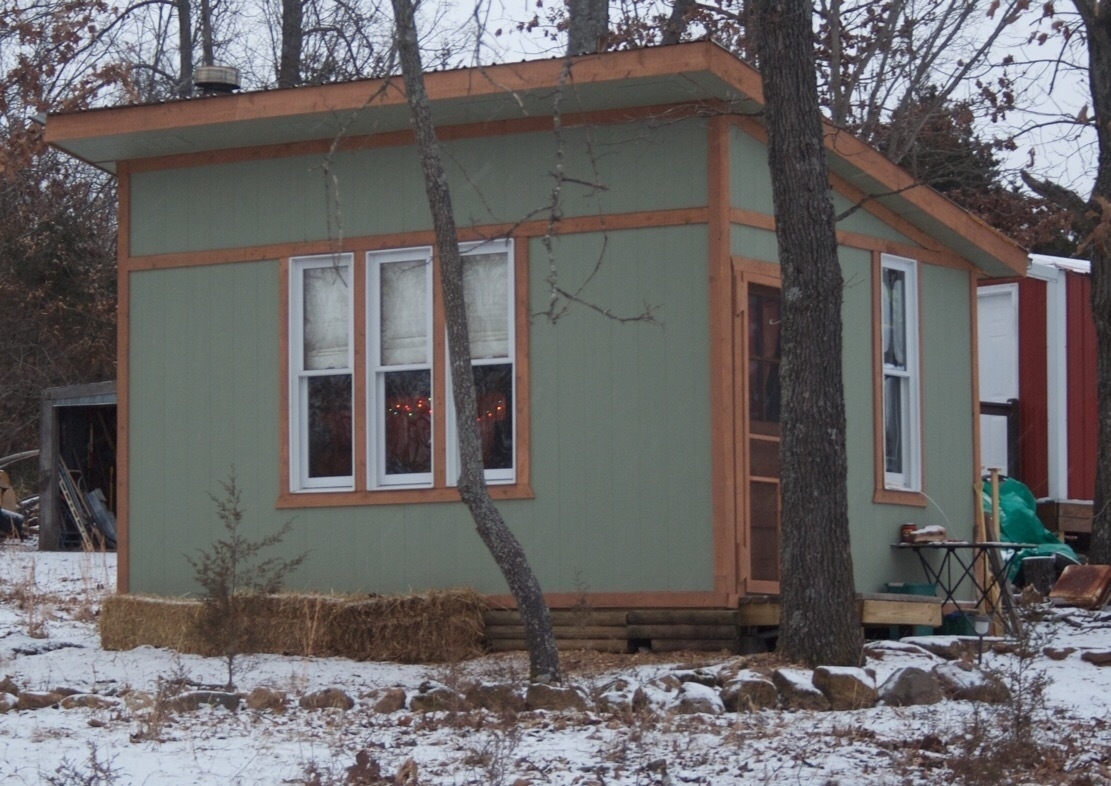 That first winter I also experienced the joy of uninsulated floors! Cold. Too late to do much about it I put down some carpeting and wore slippers. Future plans would include reducing airflow under the cabin as well as increased layers of carpeting. I did come up with a quick fix to slow the airflow on the west side of the cabin which included some salvaged garden timbers already assembled to the right height supplemented by a few bales of hay. The west side was the most vulnerable not only because it had the greatest gap but also because the greatest incoming wind, often over a frozen lake, was from the west. My cabin takes the full force as there aren’t that many trees on that side and those that are there are, of course, without leaves in the winter!
That first winter I also experienced the joy of uninsulated floors! Cold. Too late to do much about it I put down some carpeting and wore slippers. Future plans would include reducing airflow under the cabin as well as increased layers of carpeting. I did come up with a quick fix to slow the airflow on the west side of the cabin which included some salvaged garden timbers already assembled to the right height supplemented by a few bales of hay. The west side was the most vulnerable not only because it had the greatest gap but also because the greatest incoming wind, often over a frozen lake, was from the west. My cabin takes the full force as there aren’t that many trees on that side and those that are there are, of course, without leaves in the winter!
I also learned the importance of monitoring our little well shed. When temperatures dipped to 0 my heating was not nearly enough and the pipes froze. Never again. The key is “heat tape” and a combination of heat lights and/or a heater of some sort. Minimizing the waste of energy also means paying attention to the weather. When the weather warms the heat goes off but of course it is essential to stay on top of things. As soon as temps dip down into the 20s the protective heat has to go right back on.
[caption id=“attachment_877” align=“aligncenter” width=“866”] Ice funnels that form when moisture in grass freezes and expands outward.[/caption]
Ice funnels that form when moisture in grass freezes and expands outward.[/caption]
But it wasn’t just cold feet I had to get used to. I’d become comfortable using the outhouse during the warmer months. Using an outhouse at 0° is an altogether different experience! Brrrrrrrr. But as with the carrying of water I viewed it as a learning experience and an expansion of my personal perspective. Funny thing really, I got used to it. Not to say it wasn’t cold each time but it just became a part of life. Yes, it was cold but I survived just fine. Truth is it’s probably pretty funny for anyone within earshot of those first moments of my ass meeting toilet seat as my yelping could probably be heard for several hundred feet. Sorta like someone jumping into cold water. I always have a chuckle at myself in those moments.
One of the benefits of the outhouse, summer or winter, spring or fall, was the sense of connection with the outdoors. In an interesting way using an outhouse or just peeing outside reminds one that in the end we are also animals. Yet another benefit is the usage of “wastes” for the enrichment of soil. Eventually the poop is composted and can be safely used for fruit trees. The urine is great for adding nitrogen to compost. What goes in comes out and it’s best to put it to good use.
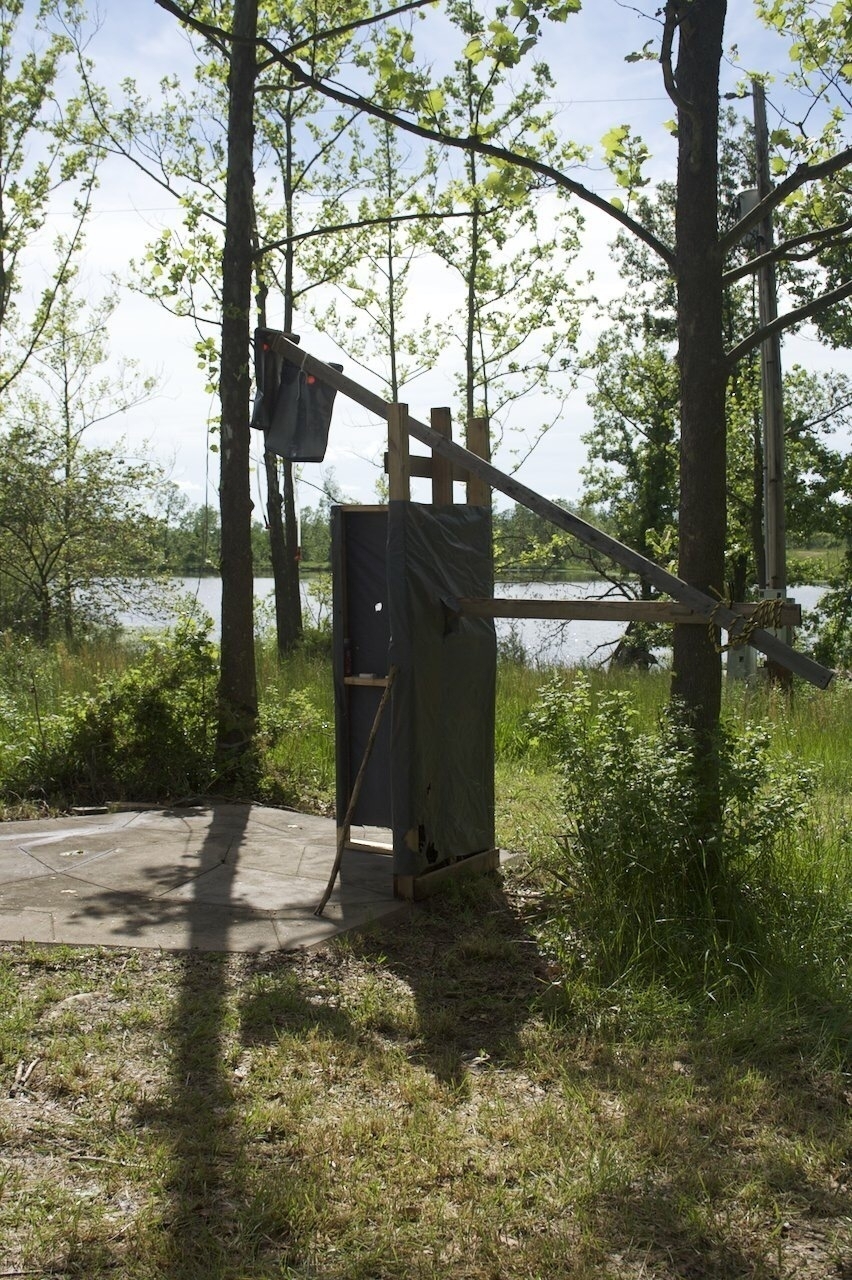 You may remember that I also did not have an inside shower. I used the outside solar shower until it got cold. I used the shower in Kerry and Greg’s cabin until they turned their water off for the winter. That was probably late November. Now, this is where some of you get grossed out and where I get to share my thoughts on modern bathing habits. You see, for me, this wasn’t a huge problem. And yes, I hear you snicker, but what about the people around me? Might my stink not be a problem for them? Oh, I see a rabbit hole, let’s jump in!
You may remember that I also did not have an inside shower. I used the outside solar shower until it got cold. I used the shower in Kerry and Greg’s cabin until they turned their water off for the winter. That was probably late November. Now, this is where some of you get grossed out and where I get to share my thoughts on modern bathing habits. You see, for me, this wasn’t a huge problem. And yes, I hear you snicker, but what about the people around me? Might my stink not be a problem for them? Oh, I see a rabbit hole, let’s jump in!
Modern humans of the “developed” world are far too concerned with being “clean”. We’ve got antibacterial soaps and wipes. Women are convinced that they must shave or otherwise remove much of their body hair. So as to limit our body odor we use deodorants and anti-perspirants. Some people shower daily. I’ve known some that shower twice a day regardless of whether they break a sweat during the day. What are we so afraid of? My disdain for too much cleanliness is not just opinion. Oh no, I’ve got science too. Well, to be specific I have preliminary science because as is often the case, science is tentative.
Ever heard of the “hygiene hypothesis”? In short the idea is that we have become too clean. In our war against “germs” we have greatly reduced the helpful bacteria on which we depend. The contention is that we have become more susceptible to asthma and autoimmune problems because we have reduced our body’s exposure to “germs” which it uses to program the immune system. This is especially important for children who’s bodies are most in need of the “programming”. Not only that but our gut and skin biomes have been greatly reduced. Again, these are necessary bacteria (and fungi and archaea) with which we have a symbiotic relationship. We_ need them to survive._ We call this aggregate of microorganisms the human microbiota. Get used to it, your “body” is actually a community with non-human cells outnumbering human cells by 3 to 1. Fantastic!
For a more academic read there is this. There’s a great deal to be said on the subject and I don’t want to go too far down this rabbit hole. For now I’ll conclude by suggesting that I am clean enough. I found ways that first winter to clean-up without a shower. And for the record, while I wouldn’t want to use an anti-perspirant I am happy to use deodorants. Interestingly I’ve been told by family and a few close friends that I have a unique Denny smell. They contend that it’s not a bad body odor but just a unique smell. I’m guessing that for most of human history each person had such a personal odor. It’s only in recent times that we’ve sought to so completely remove it’s traces.
Okay, now that we’ve covered that I’ll bring the tale of the first year to a close. I not only survived the winter but I thoroughly enjoyed it, frozen feet, icey butt cheeks and all. Spring was around the corner and I would soon be very busy with the garden. Tomato and other warm season crops were seed planted in trays and cool season crops such as peas and lettuce were direct seeded into the garden. The plan for the spring included a chicken coop and attached greenhouse as well as a new cabin for Kerry and Greg’s kids. Oh, and honey bees! Lots to do. More to come!
192 Square Feet
A note about writing this. My initial intent was to post a bit about what it’s like to live in a small space but as I worked on that post it occurred to me that for my own purposes I’d like to have a more complete story of this process. I thought it would be interesting enough to offer more details is a series of posts so, I present you with part 1.
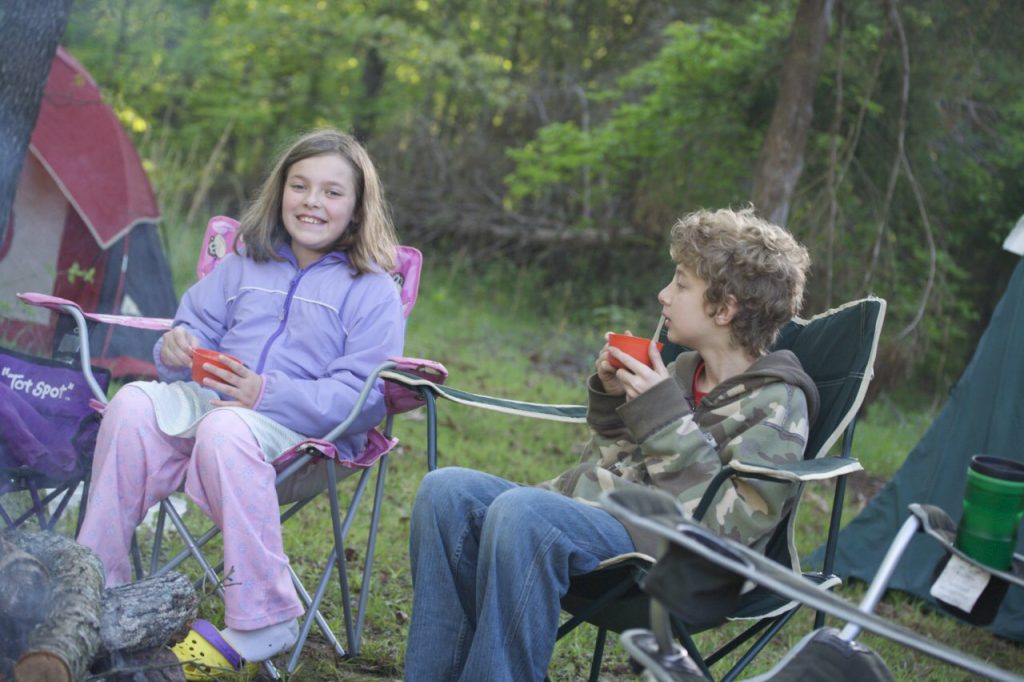 Camping during construction. My niece and nephew.
Camping during construction. My niece and nephew.
In the spring of 2008 I made a decision to begin a new living arrangement. With the economy tanking and my life in a period of transition I put thoughts of moving to Maine or Oregon on hold and decided to stay closer to my family in Missouri. With the help of my brother-in-law Greg (who is the real builder) we began a project the family had long talked about. A little village of sorts on our share of land that had been left to us by our grandparents.
Now, before I get into the story I should offer up that I am not a builder. My first recollection of building things was watching my parents help my aunt and uncle as they built a barn and house. But the adults worked, the kids played. I didn’t learn much. A few years later I remember helping my dad build our deck. I should add that my dad is also not a builder. My recollection of the process was one of frustration. My dad’s frustration as well as my own. In the end we had a very nice deck but I don’t recall it being an enjoyable or rewarding process. It may well be that I was just a bratty kid that didn’t want to spend his precious weekend helping build a deck but other memories reinforce the idea that my dad was often frustrated when trying to take on such projects. He wasn’t confident and didn’t enjoy it or at least that’s my recollection. I say this to help explain my own adult tendencies to avoid construction projects and my own lack of confidence in such endeavors. But in the spring of 2008 I did want a cabin and I wasn’t prepared to pay for one. Given that we had larger plans for multiple tiny buildings the choice to learn and work was obvious.
I knew some of the basics. Previous experience (as an adult) included replacing a part of the roof at deCleyre as well as helping a friend with a roofing job. Also, I’d helped Greg on a few renovations of their home. He had the experience and had a pretty good idea of what he was doing but I’m observant and had watched him closely. During their home renovations I’d used a nail gun, hammer, circular saw, sawzaw, jigsaw and drill. I had a pretty good idea of what it meant to build a standard 2x4 wall. I ran the electrical wiring and helped put up the drywall. I knew the building of my simple one room cabin was really just a process of building a wooden platform, four 2x4 walls, and, finally, a roof. Then all the details of adding in windows, doors, outlets, insulation, inside walls, etc. Not only did we build my cabin but we renovated a shed and built 4 other structures. At this point I don’t doubt that I could build a cabin on my own should I need or want to. Thanks Greg!
Our first building on the property was an outhouse because we knew we’d need some sort of facilities. We had that built in a weekend. It was a simple structure designed so that I could easily empty a large bucket when full. I set-up an out of the way area for a humanure compost pile which can be safely used after a couple of years .
The following weekend we set-up tents and an outdoor kitchen in an old shed. Then we spent a month (weekends only) building my 12x16 cabin. The plan for the cabin was simple. I needed something big enough to live in. I don’t own much so basically a single, multipurpose room for sleeping, working, hanging out, food storage/prep and eating. No bathroom as I planned to use the outhouse and bathing would be done outside with a solar shower and then I’d have figure something out for the winter.
Looking back on it now there are two things I would have done differently. I would have insulated my floor and I would have built it bigger to accommodate a small bathroom. If I’d gone just 4 feet more, 12 X 20 instead of 12 X 16 I’d have more room for the bathroom. But that’s it. Generally I don’t mind the lack of a bathroom but if I stay put for the long haul I’m likely to want the convenience of one. As I expected I have found that living in a small space has worked very well for me but more about that later.
We arrived to begin work on Friday night. We set-up camp and cleaned the cabin site a bit. Saturday morning we finished clearing the site of debris and started the floor platform made of treated 2x12, 2x8, and plywood. That was finished by Saturday evening. My back was already hurting.
Sunday morning started early with building the 2x4 walls. By Sunday afternoon we had the outer wall panels up. By Sunday evening we had the roof on and had the holes cut for the windows. We had a blast and had squeezed in more than 28 hours of work in 2 days and an evening. We were exhausted. We left Sunday evening after dark and I have no idea how we got home. Somehow Greg managed to stay awake while he was driving though I have no idea how.
The second weekend was adding in windows, door and electrical. I actually moved in at the end of the weekend because while it was far from finished it was a pretty weather proof shelter. It was like being in a tent except the eaves were not yet enclosed which meant flying critters got in. I woke up to a bird in the cabin one morning. There were a few flies, june bugs and other assorted winged creatures including a couple of birds that popped in one morning. There were mice. While I had my cabin ready for electric we did not yet have service hooked up so I would be using lanterns for a couple weeks. But it was home and I was happy to be in it. If that meant sharing it with a few critters well then, so be it. I was eager to get started on the garden. I had several trays of seedlings that we’re going to need a home and my garden consisted of a small field grasses and flowers.
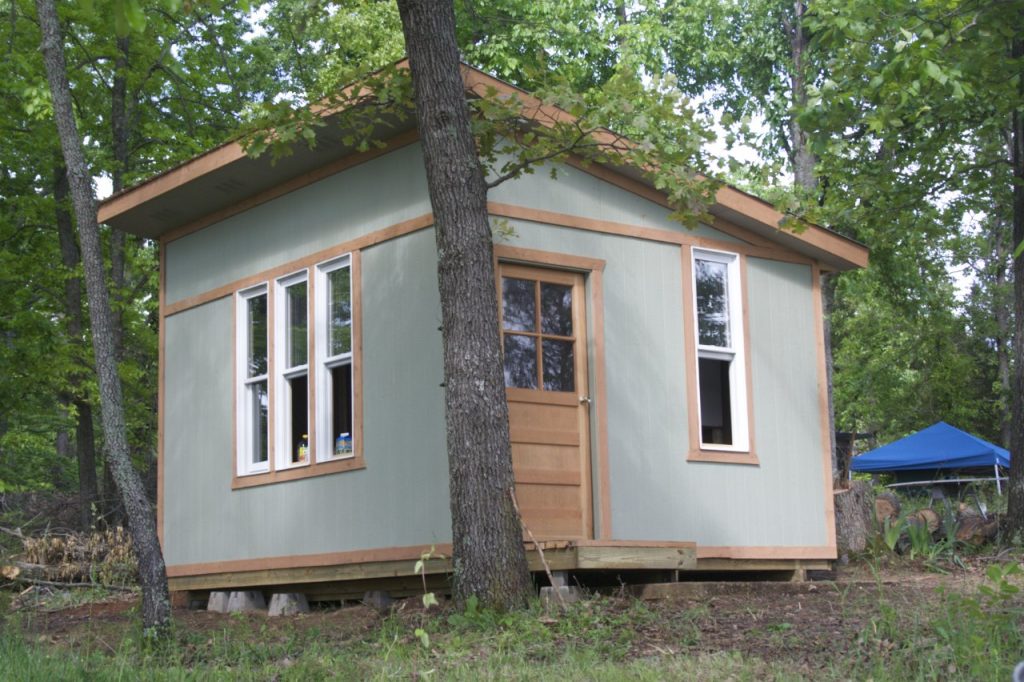 Nearly finished on the outside!
Nearly finished on the outside!
The next couple of weeks were spent alternating between gardening and building. On weekends Kerry and Greg would come with the kids and we would build while the kids played. They’d not had a whole lot of time at the lake up to this point and were just getting to the age where they could explore a wee bit. Mornings were spent around the campfire then we’d break off to work on the cabin and the kids would fish or swim with Kerry. By the last weekend of May the cabin was painted and mostly enclosed. By the end of June we’d gotten the cabin fully enclosed, the cabin painted, a ceiling fan installed and the wood slat ceiling was in place.
My weekdays were spent gardening and cleaning up the various bits of debris left from a tornado that passed through 2 years prior. I refused to use any gas tools with the exception of a chainsaw. All the darkening was accomplished with a mix of labor and time. I cleared out the garden area with a sickle and then an old fashioned non-gas reel mower. My family thought I was nuts but I put it down to idealism. It took longer to do it the way I did but it was great exercise and frankly, I enjoyed it immensely. The spring, summer and fall of 2008 might be best described as pure joy and exhaustion. In my 39 years I had never worked this hard. I’d always worked, always kept busy but never had I physically worked from sun-up to sun-down. I fell into bed each night aching and exhausted. I was gaining a whole new appreciation for what life would be like without modern conveniences, without oil.
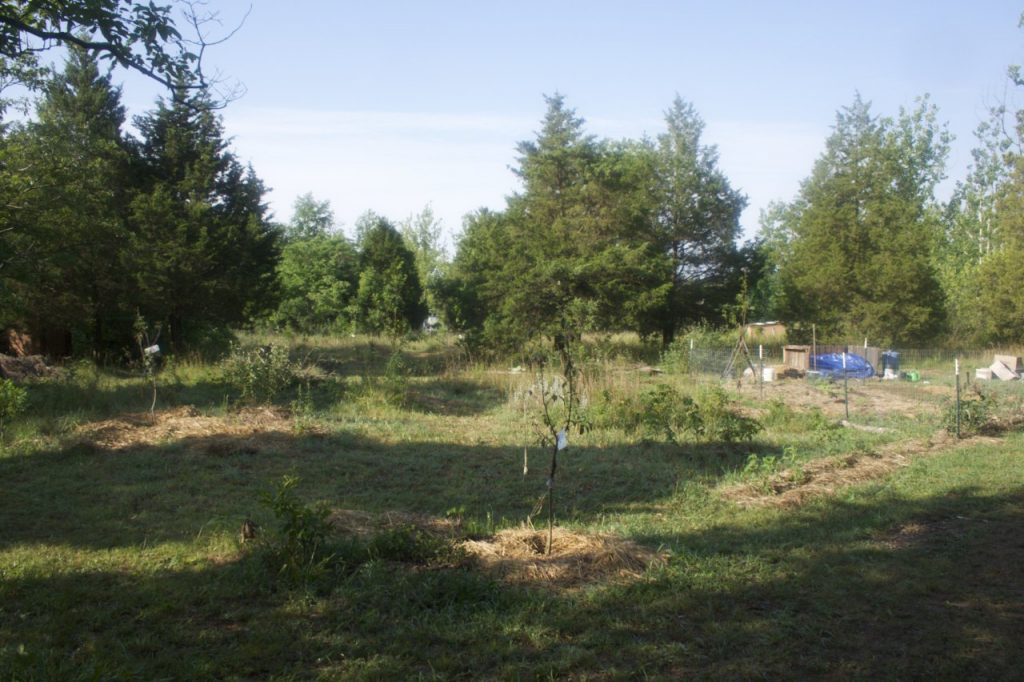 Forest garden and orchard. Fencing up, beds in, compost pile underway.
Forest garden and orchard. Fencing up, beds in, compost pile underway.
I had a small garden going by the middle of June. I considered it garden phase 1. In a month I had put up fencing, put in double-dug beds and mulched it all with cardboard and straw. Greg had begun picking up fruit trees on sale at the big box stores towards the end of June and they needed to get planted. I sickled and reel mowed pathways into a couple of areas I had planned for fruit trees. July and August will remain a blur of planting fruit trees, hauling lake water in 5 gallon buckets and weeding the garden. I’m happy to say that I didn’t loose a single tree which is saying something because these were all pretty neglected when they got here as they were sale trees that hadn’t sold at Lowes and other places. By the end of July we had a mix of peach, plum, apple, and a single pear, about 15 all together.
In mid summer Greg and Kerry found a good deal on a shed that would become the base of their cabin. We had the shed hauled from 60 miles away and added it to our budding mini-village. It’s a work in progress that continues today with plans to close in the current porch and add a new porch of recently salvaged decking.
At some point in mid summer I also began clearing out the lake front which had a downed tree covered in tall grass and flowers. There was another tornado downed tree behind my cabin and damaged trees all around the area. I gradually removed branches and cut the fallen trees down to firewood sized logs and sickled away the tall grass. Yes, this was the summer I finally became familiar with the chain saw. Previous to this I’d only ever used a chainsaw a handful of times. I was never comfortable doing it in part because I did it so infrequently. By the fall of 2008 I’d racked up many back-breaking hours with my new friend, an old red Homelight which I’m still using today. It had been my dad’s but he loaned it to me and then gifted it when he saw that I was actually using it far more than he had occasion to. It’s not the biggest chainsaw but big enough to handle small to medium tree trunks. By early October I had one or two ranks of wood chopped and ready for winter and the lake front was cleared enough that I now had a mostly unobstructed view of the lake.
Greg had come down several more times through the summer and in early August the walls had all been insulated and finished with wood paneling. As the leaves began to turn to their fall colors we put a bed and storage/guest sleeping loft followed by the wood stove. One of the last projects of the year was putting in some salvaged cabinets and a closet with some shelves and a countertop. My “kitchen”, improvised for most of the summer, started to look like a real kitchen. For much of the summer I’d used an outdoor sink set-up that functioned pretty well. But as the cold weather would be coming soon I decided it was time to move the dishwashing inside so we put in a sink though no running water. I used 3 five gallon water tanks hauled from our well house, usually just one a day. I had always been conscientious about my water use but when I was hauling all of my water by hand I can tell you I became even more careful. This was especially true in the winter when I was hauling the water 150 feet through the snow.
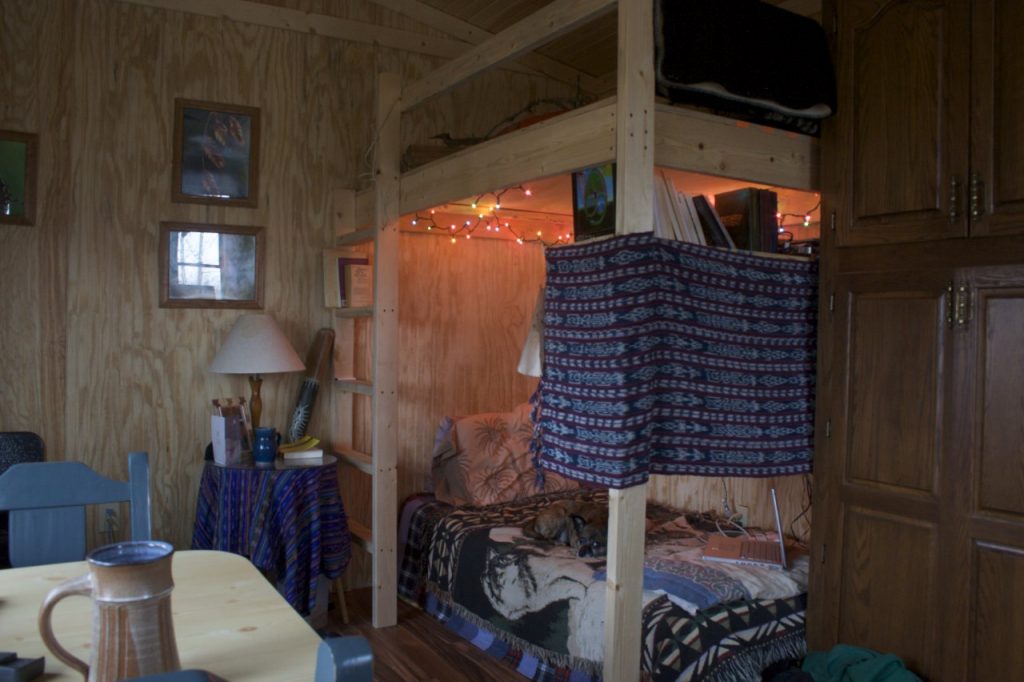 My bed, storage and guest loft above
My bed, storage and guest loft above
The summer of 2008 was busy but we were just getting started. Part 2
Tiny Cabin and Tiny Workspace Organization
My cabin interior redesign is now finished!!
Here is the finished and now neatly organized corner of my cabin that is the "office". So much better than the unused and oh so messy loft! Everything is now neatly organized on the selves which are now mostly covered by curtains (Thanks Kerry!!) for a tidy appearance.
Not only is the cabin a much more pleasant place to be but keeping it clean is now so much easier. It may just be a change in attitude on my part but yeah, I'm enjoying being organized. It's also nice having a "work space" which is something I've not had for the past few months because I replaced my previous table/desk with a futon.
The paint was a great decision. As much as I enjoyed the plain wood it needed to be protected. The paint has done wonders to brighten the place up and add to the sense of organization and tidiness. Good call!
Progress on Interior Redesign!
Thanks to my sister and brother-in-law my tiny house now has a very different feel and the space is much more effectively used. The sleeping loft that was never used except for a catch all for stuff is now gone and replaced by shelves. The mattress I had underneath is now replaced by a futon under my front window. All the stuff that never had a proper home in the cabin before is now up on shelves... It is all very neat and organized!
It's not done yet. Next weekend my sister is going to sew three curtain panels to cover the lower half of the shelving system which will give it a tidier look and keep dust out.
I also decided to paint. I've been living in it these four years with no finish on the walls because I couldn't make a decision. At this point though the plywood bead board is getting all sorts of funky with dirt, moisture, oil, and light... time for a more uniform look so paint it is!
Interior Redesign
Big things are coming to my little cabin! After four years in the cabin with a guest sleeping loft rarely used I've decided to make a few changes. I am taking out the loft and my bed beneath it and replacing it with a wall of shelves, desk and futon. The poorly organized mess in the loft will be getting neatly organized and should really open up the space. I'll probably do a bit of painting, I've never liked the fake wood exterior of the shelving unit that holds all my clothing. Will be moving my small flatscreen, MacMini, speakers and AppleTV into the top of that unit since those cloths will be organized on the new shelves. My futon is directly across from the unit so it makes for perfect viewing.
What a mess, I can't wait to get it done! Pictures and an update in the next day or so.
Inside Outside
One very interesting aspect to living here, at least for now, is the amount of time I now spend outside. Even when I’m inside I’m not really. I still have to go outside to pee or poop or get water or wash a dish. I’m always outside. I’m inside to sleep or if it is raining or when I’m cooking. Sometimes I eat outside, sometimes inside depending on the weather and time of day. Breakfast is usually inside but lunch and dinner, on hot days, is usually outside. It is as though I’m somewhere between camping and living in a house. I do have access to electricity and the cabin is water proof but it is far from living in a standard dwelling. It is a very different kind of life and I love it. I’ve never felt more connected to the life around me.

